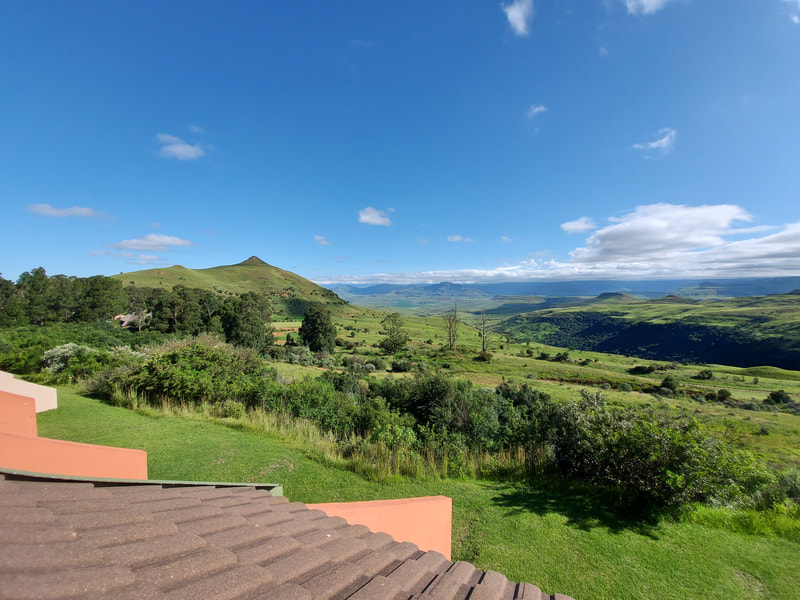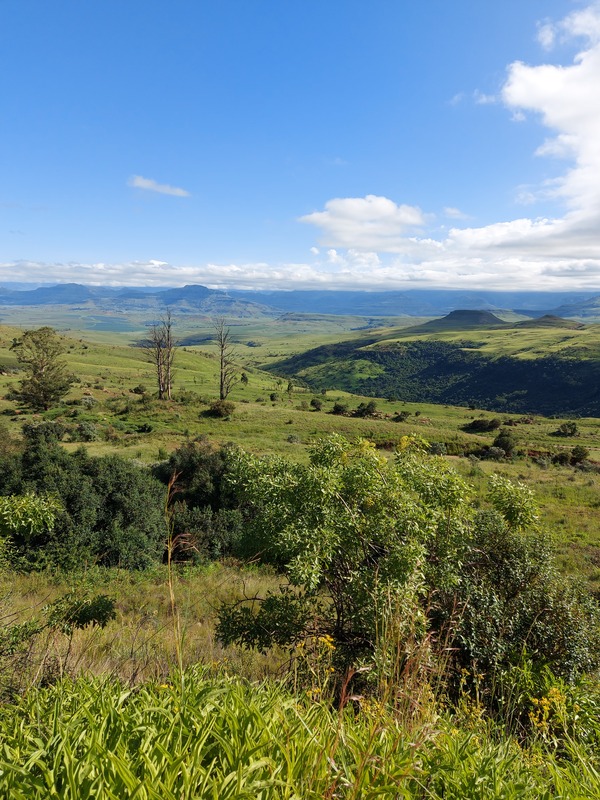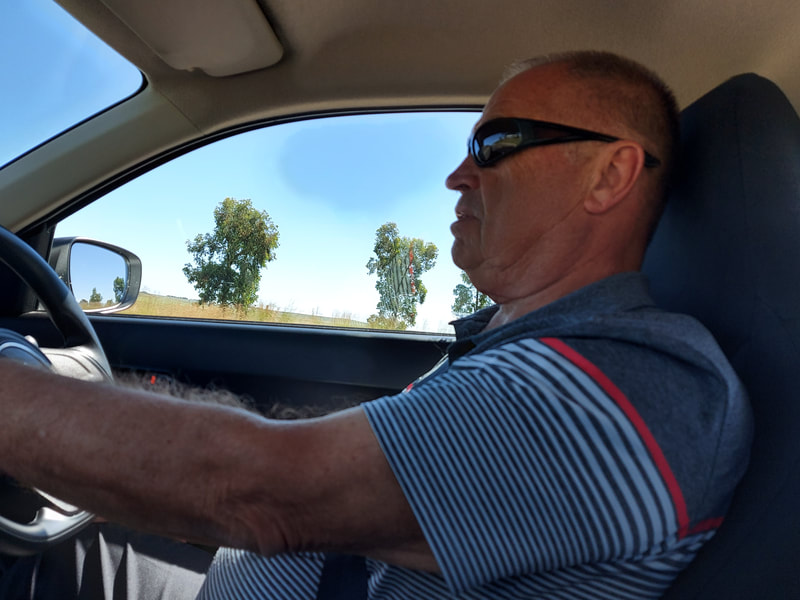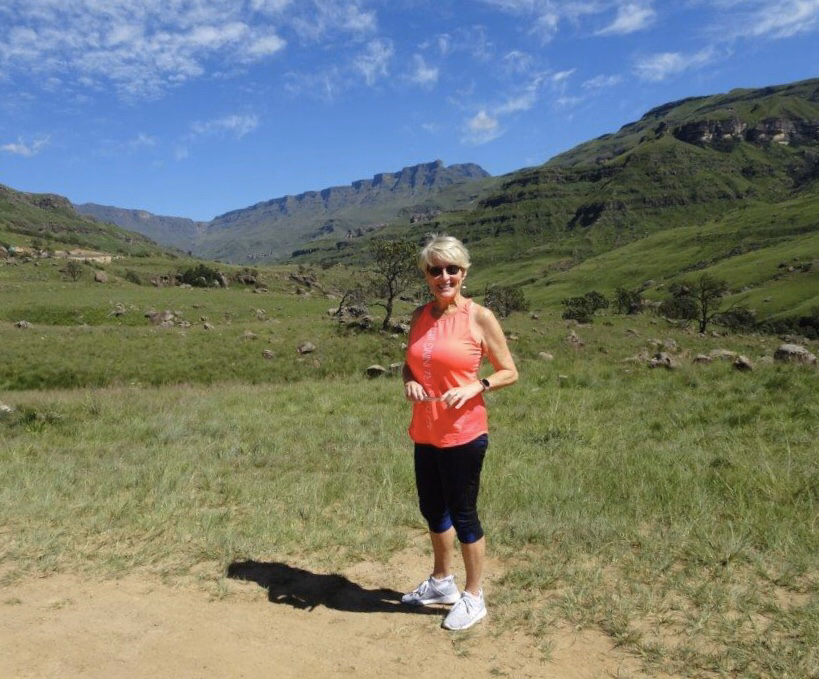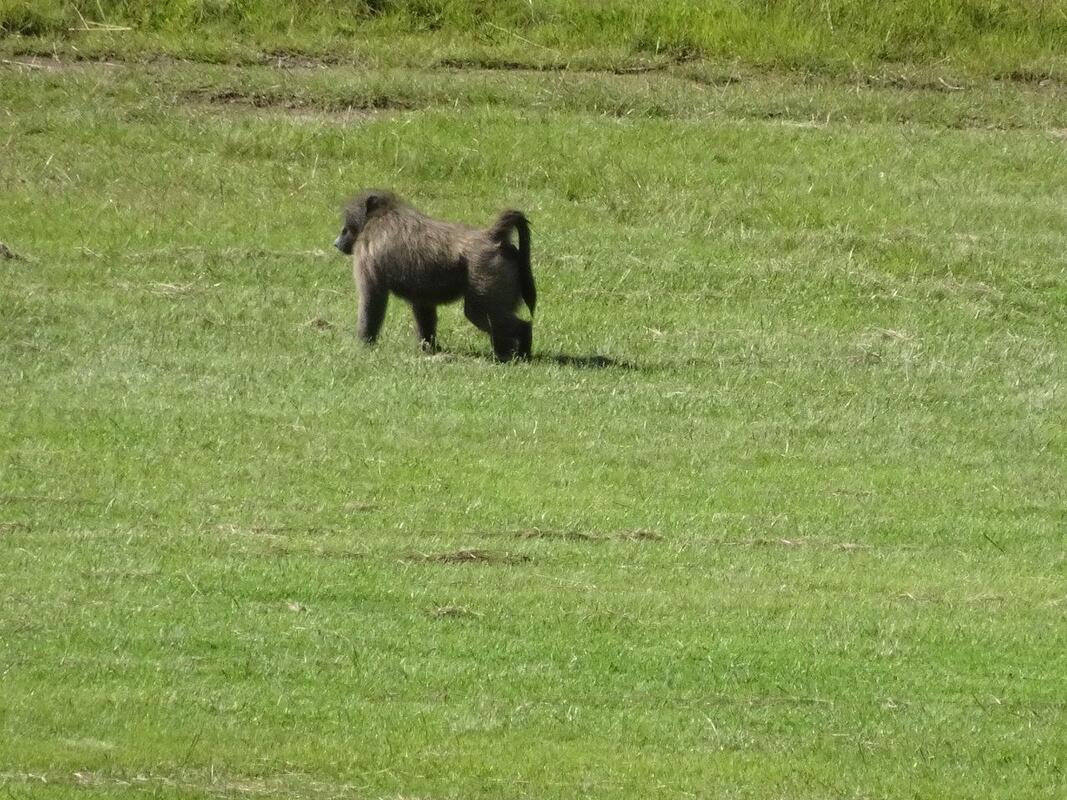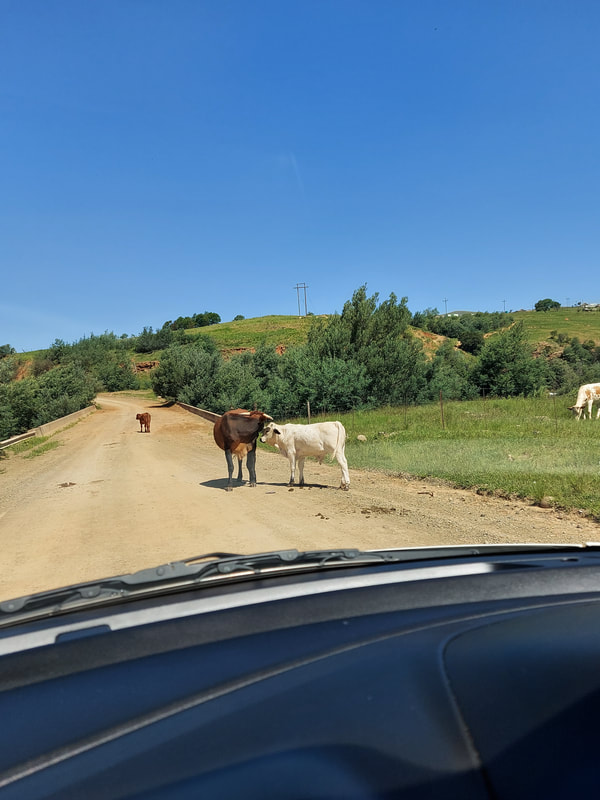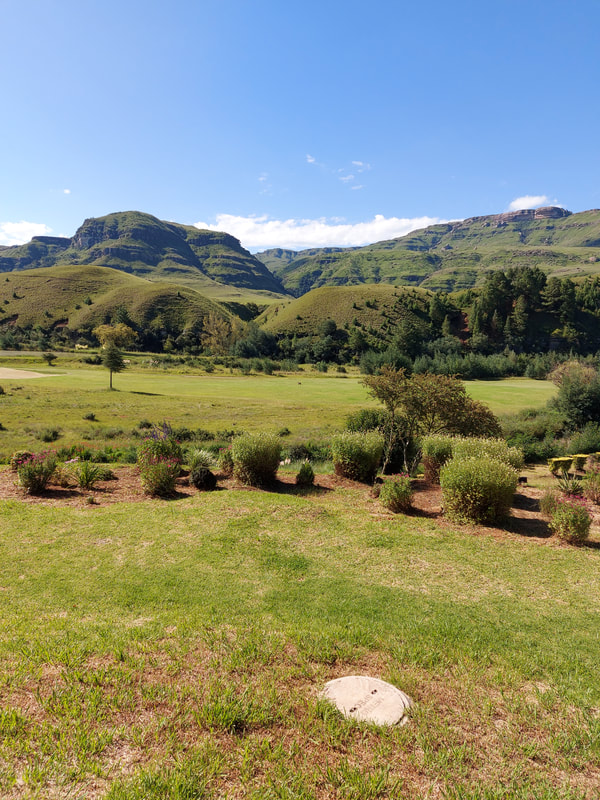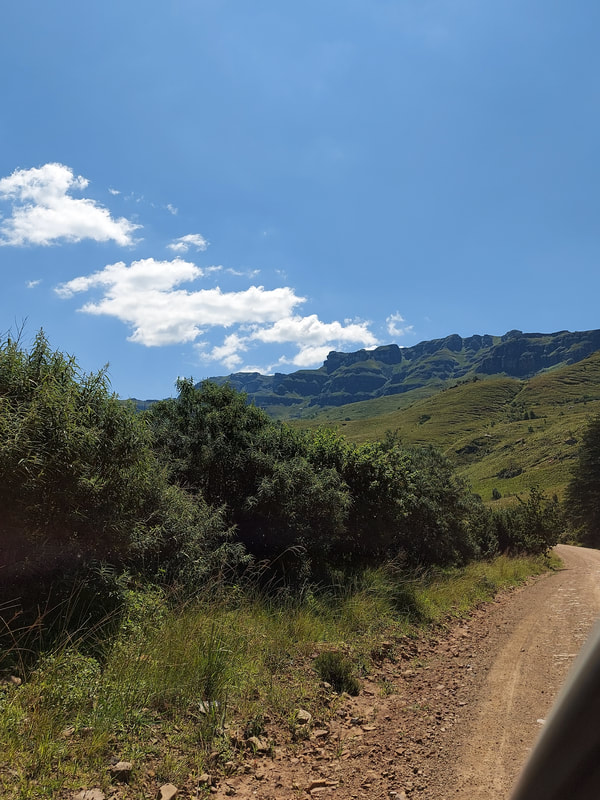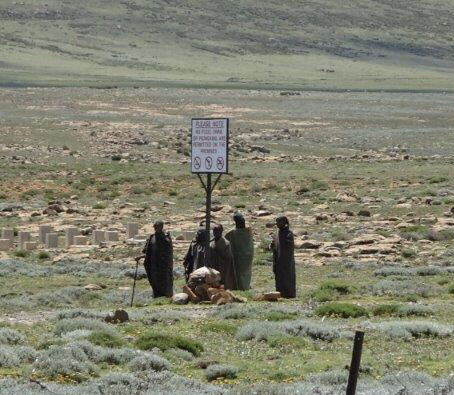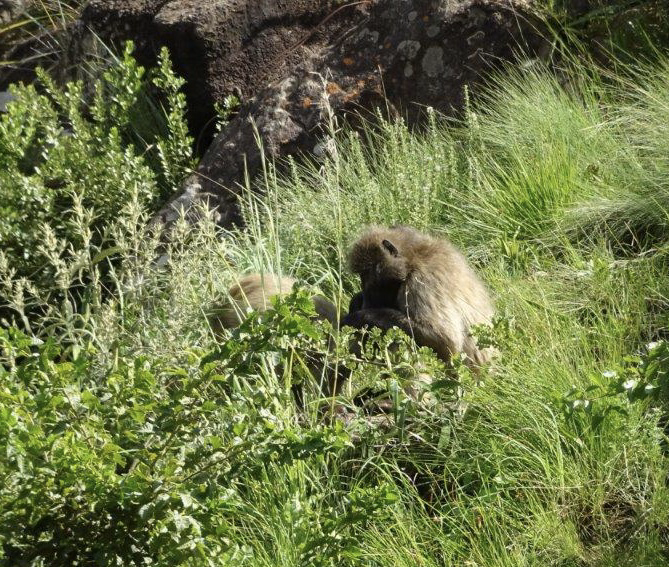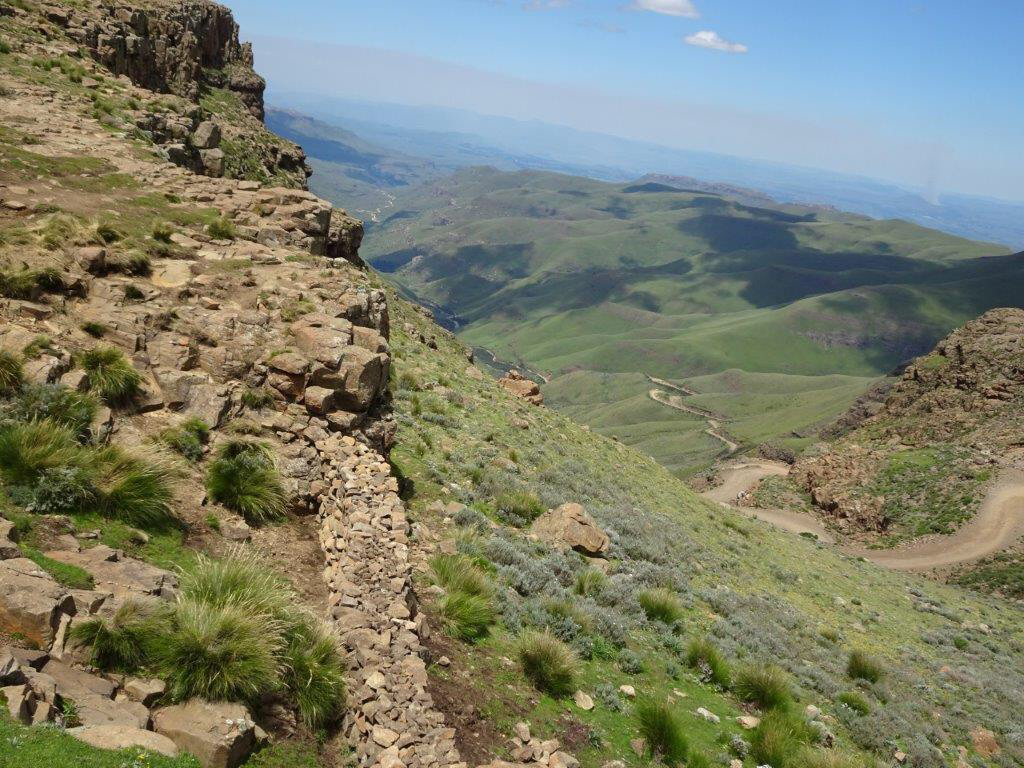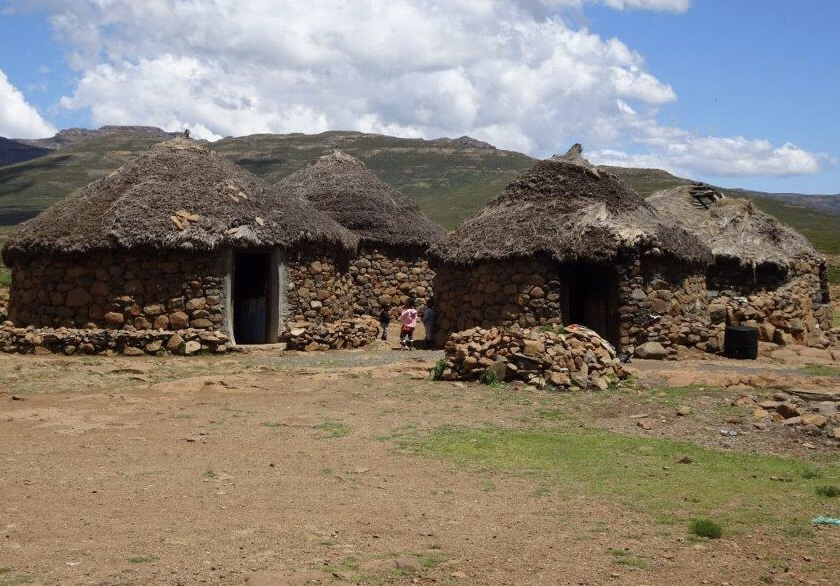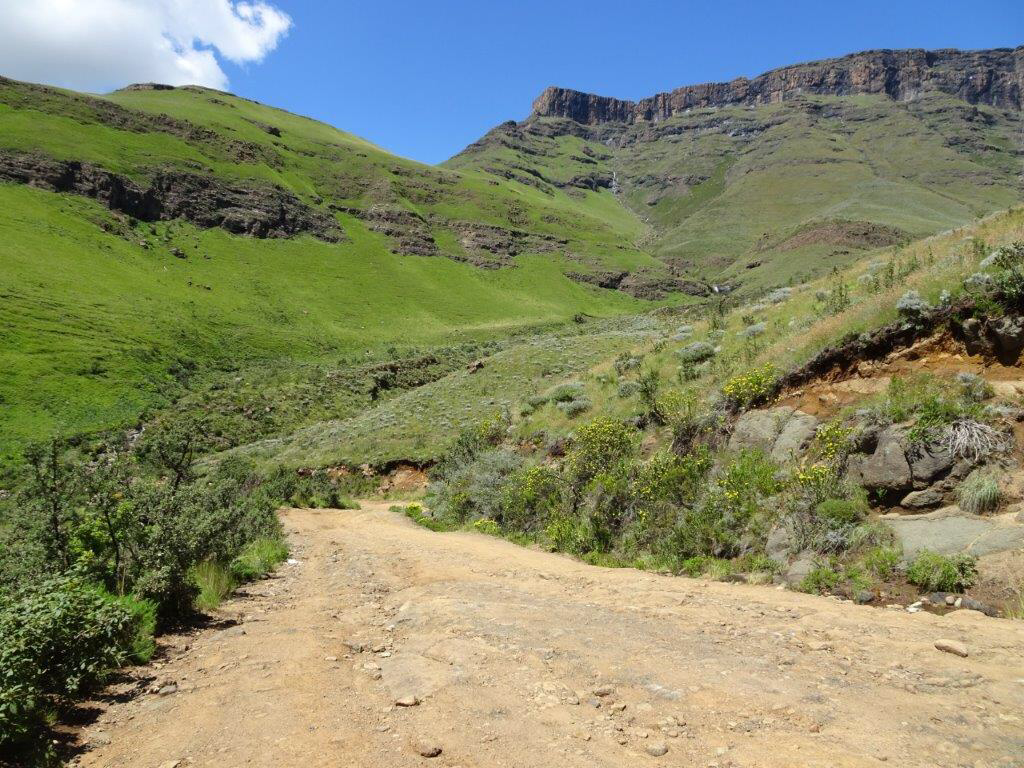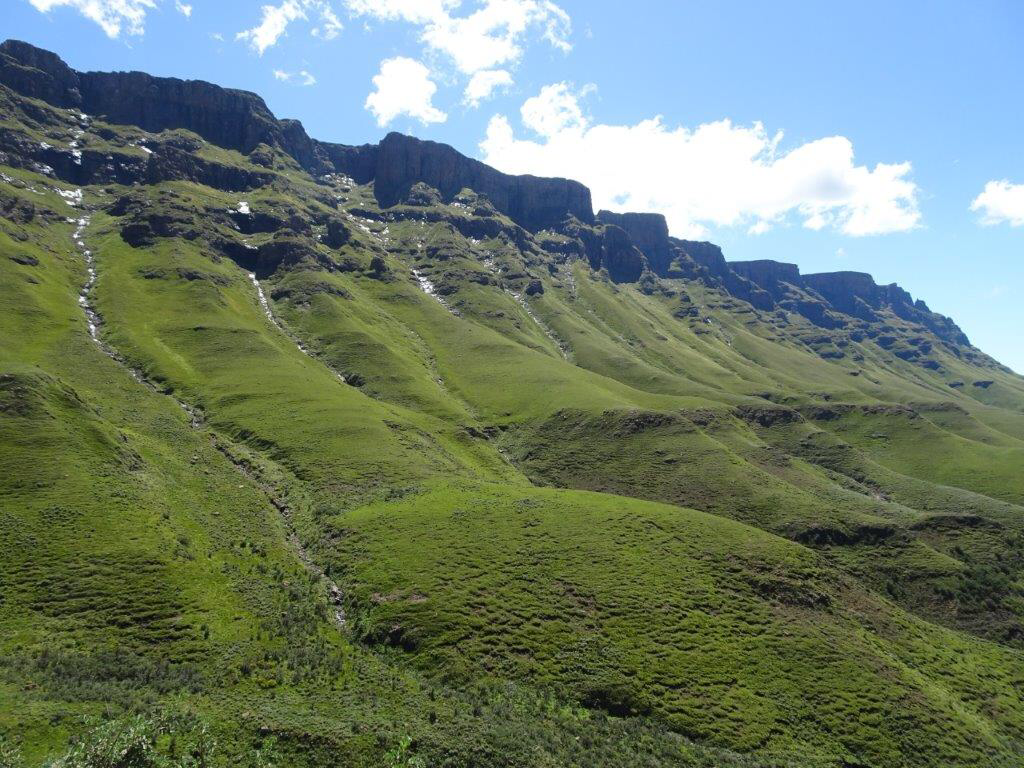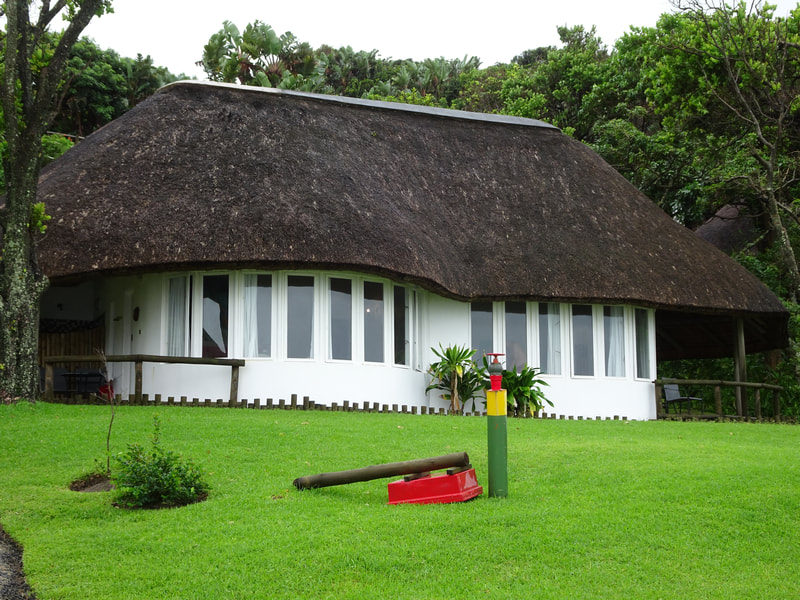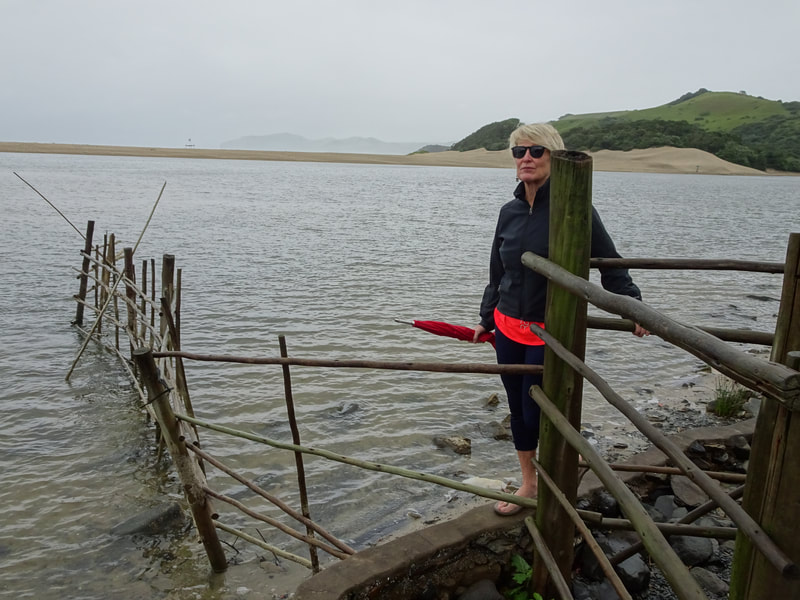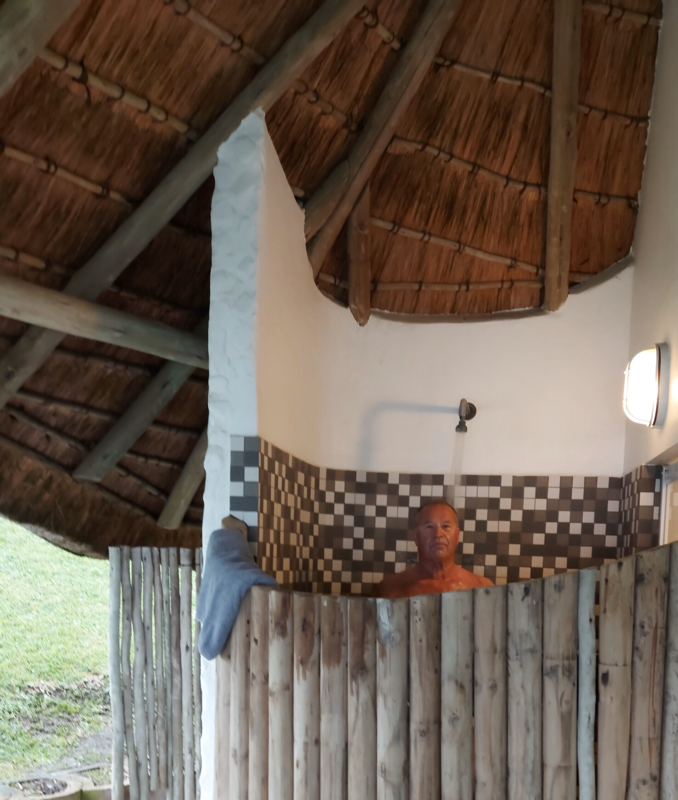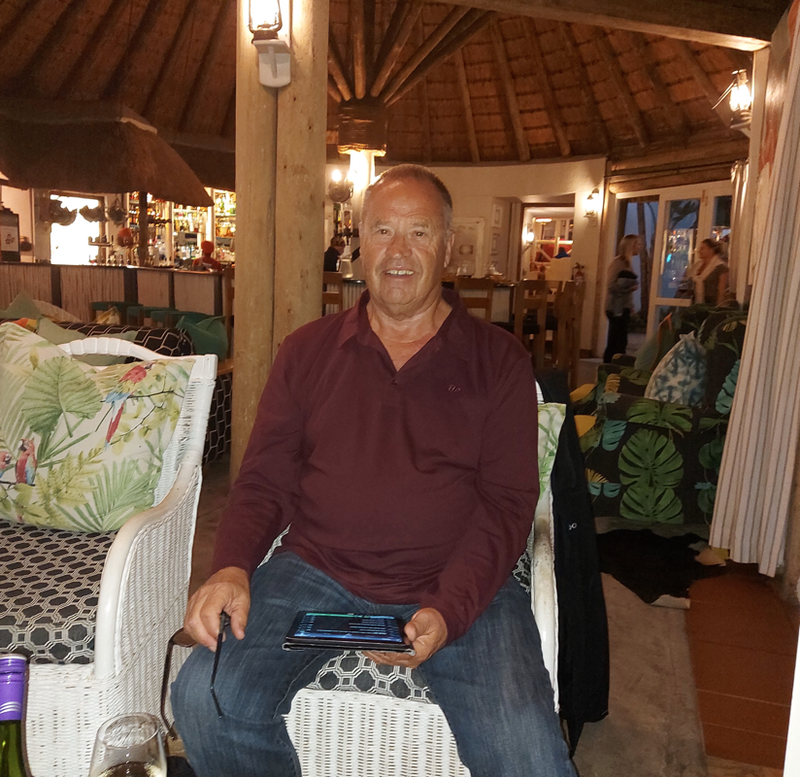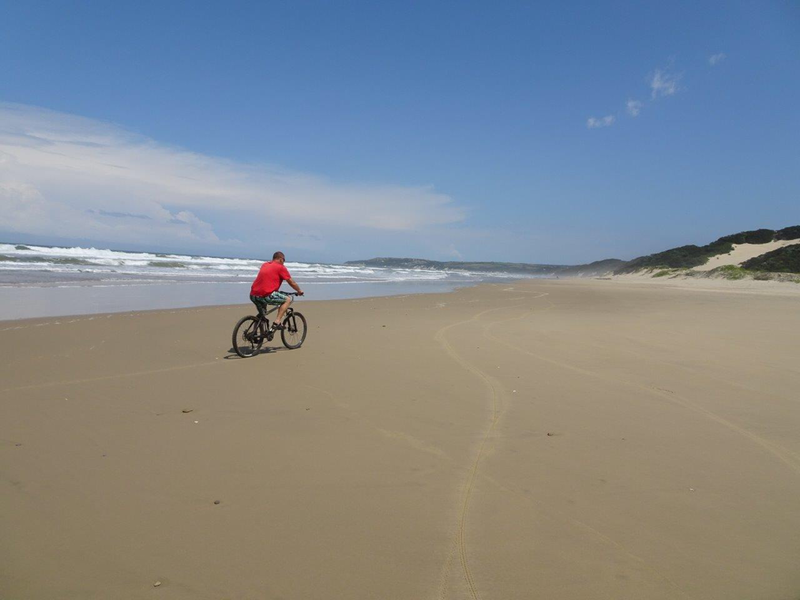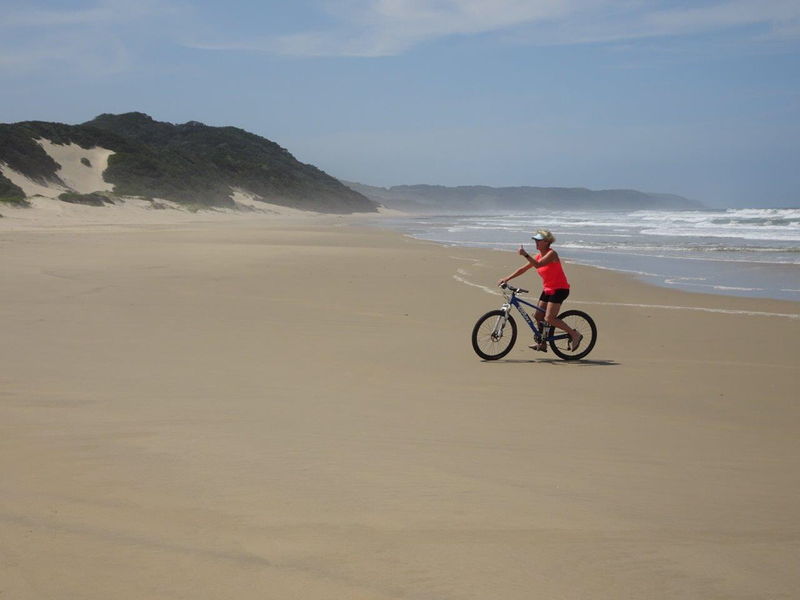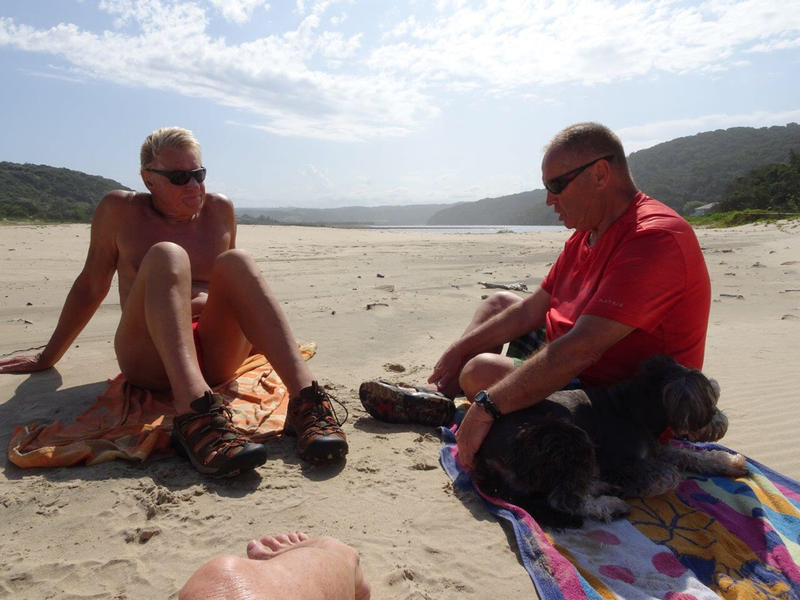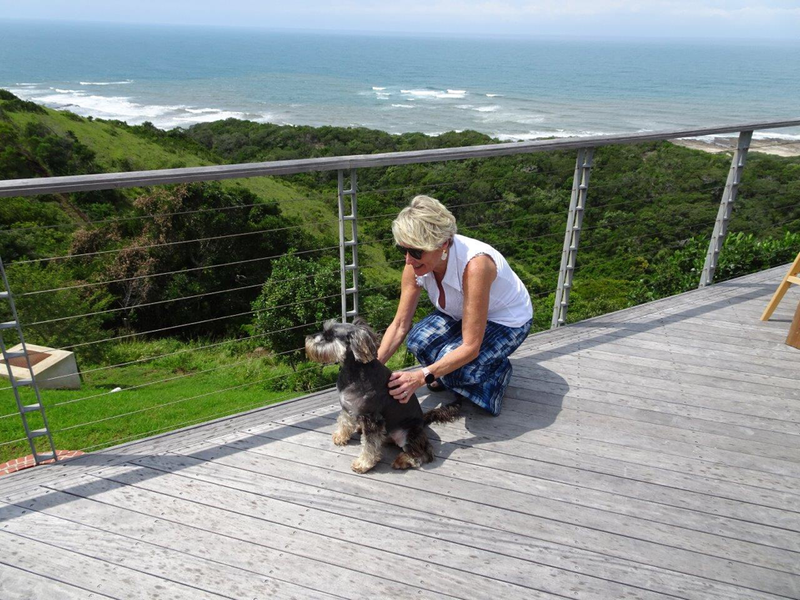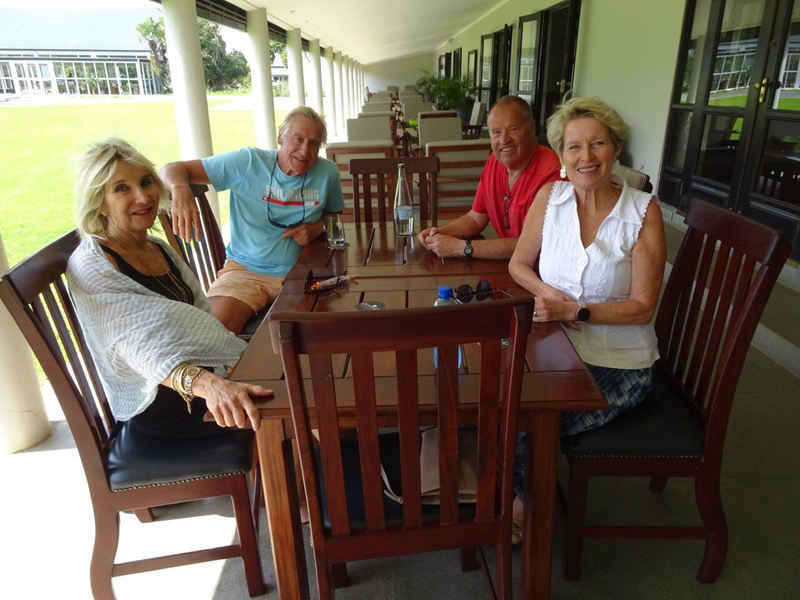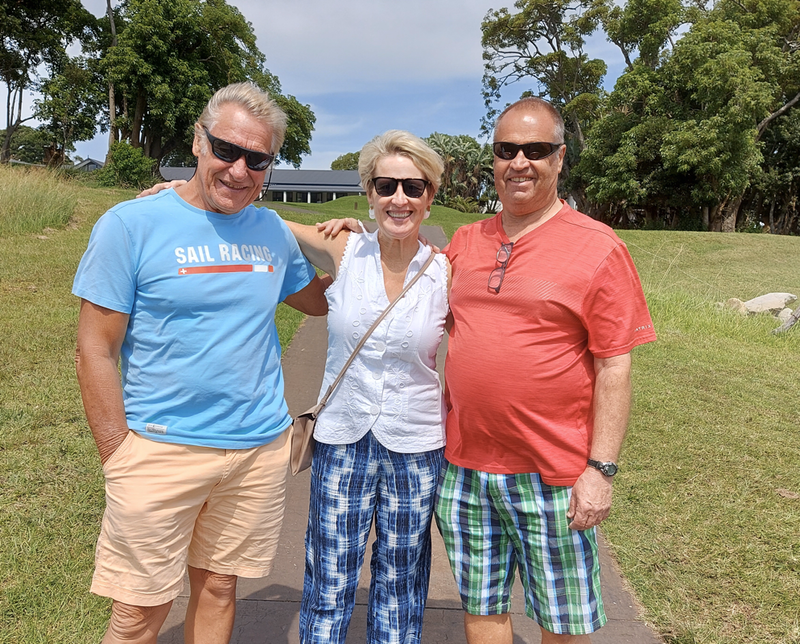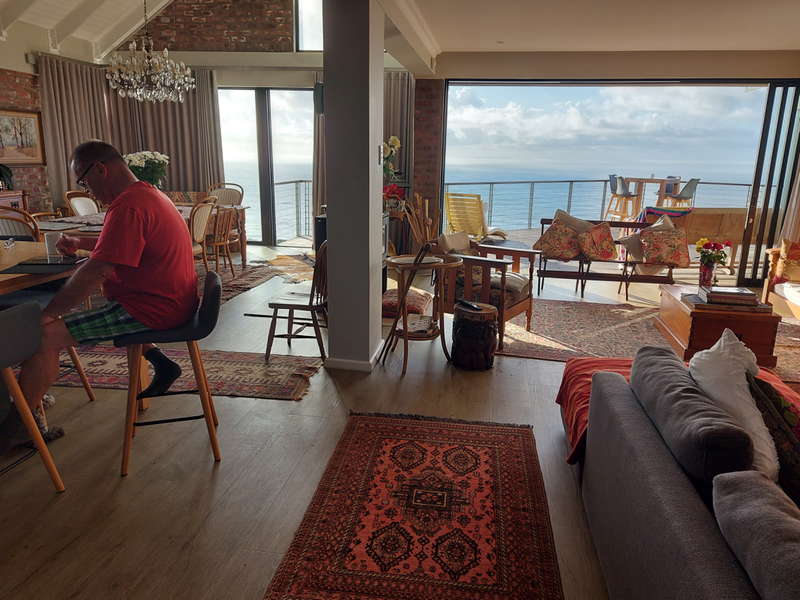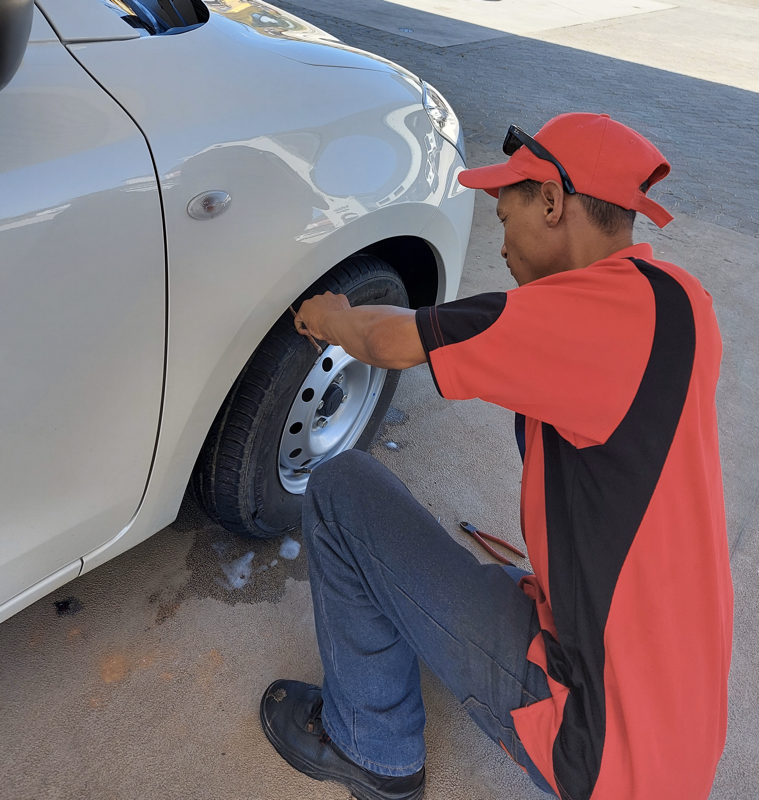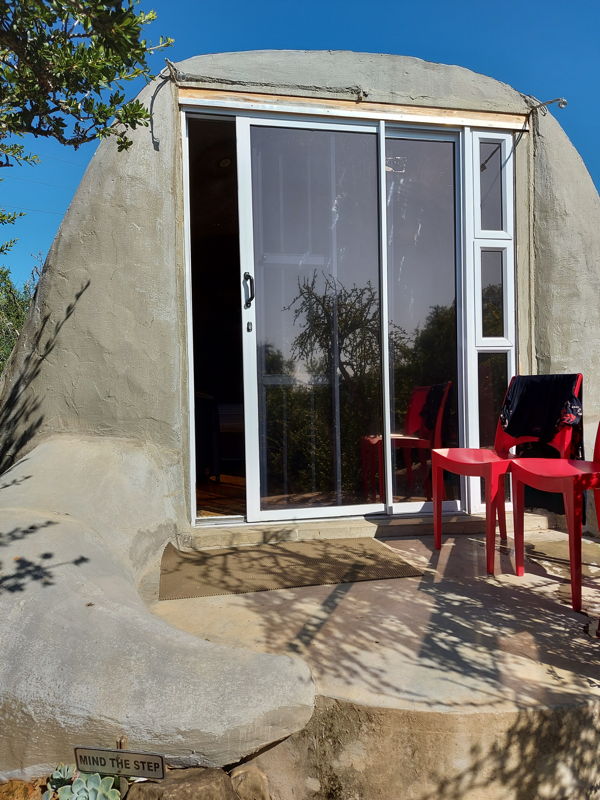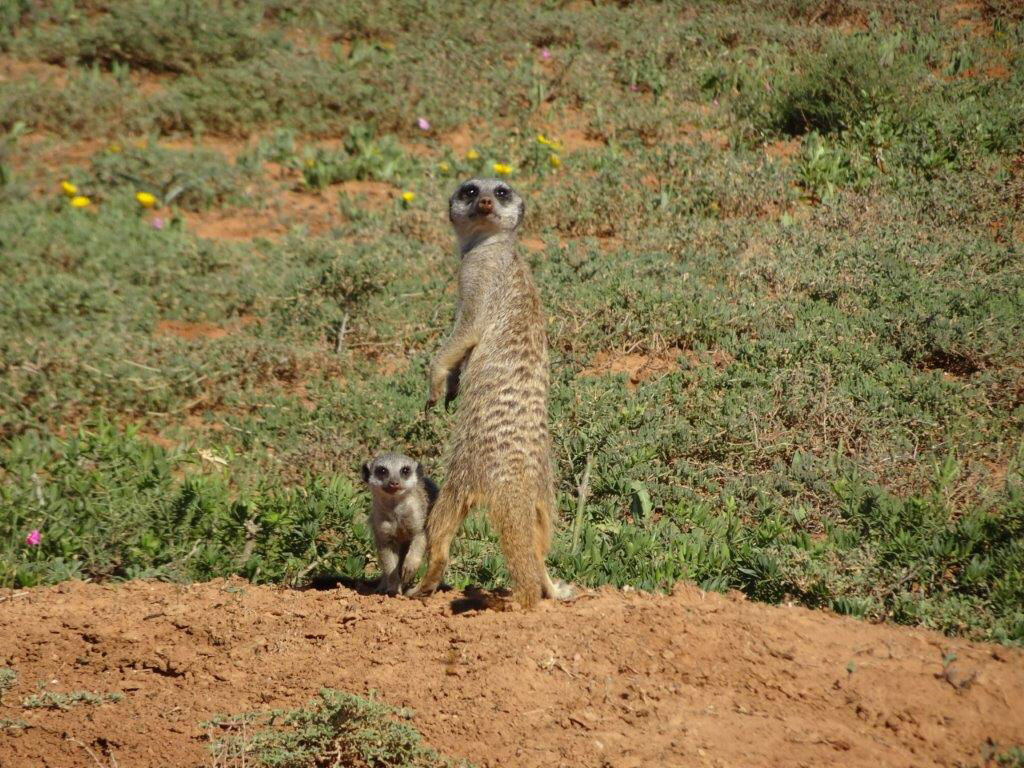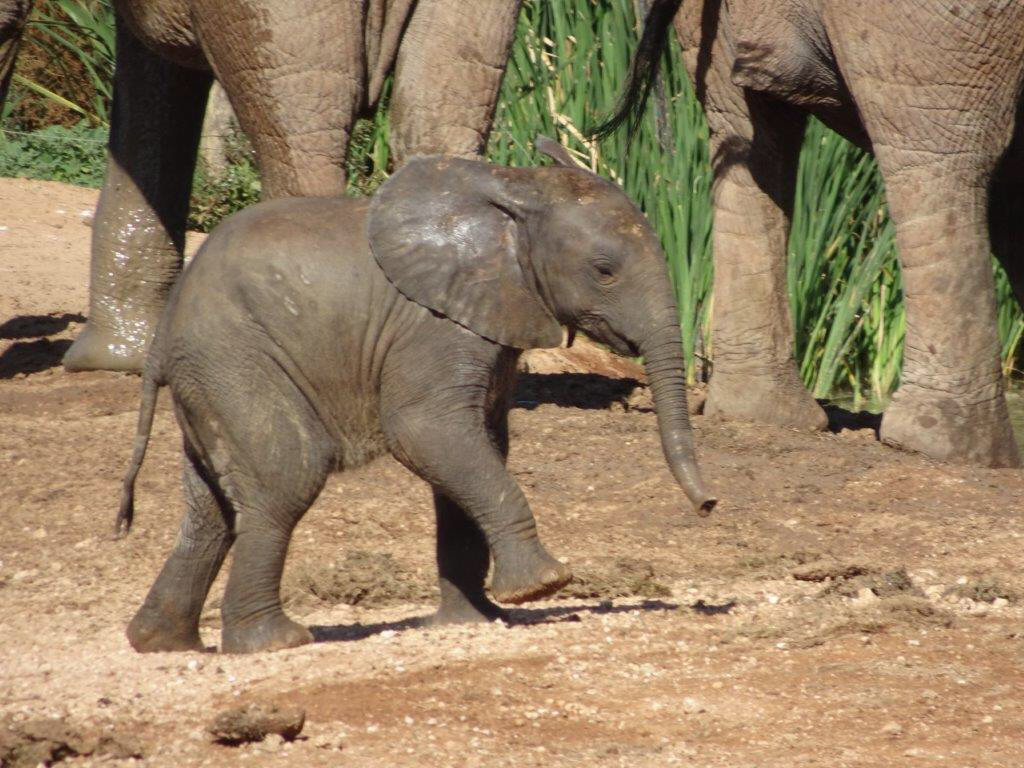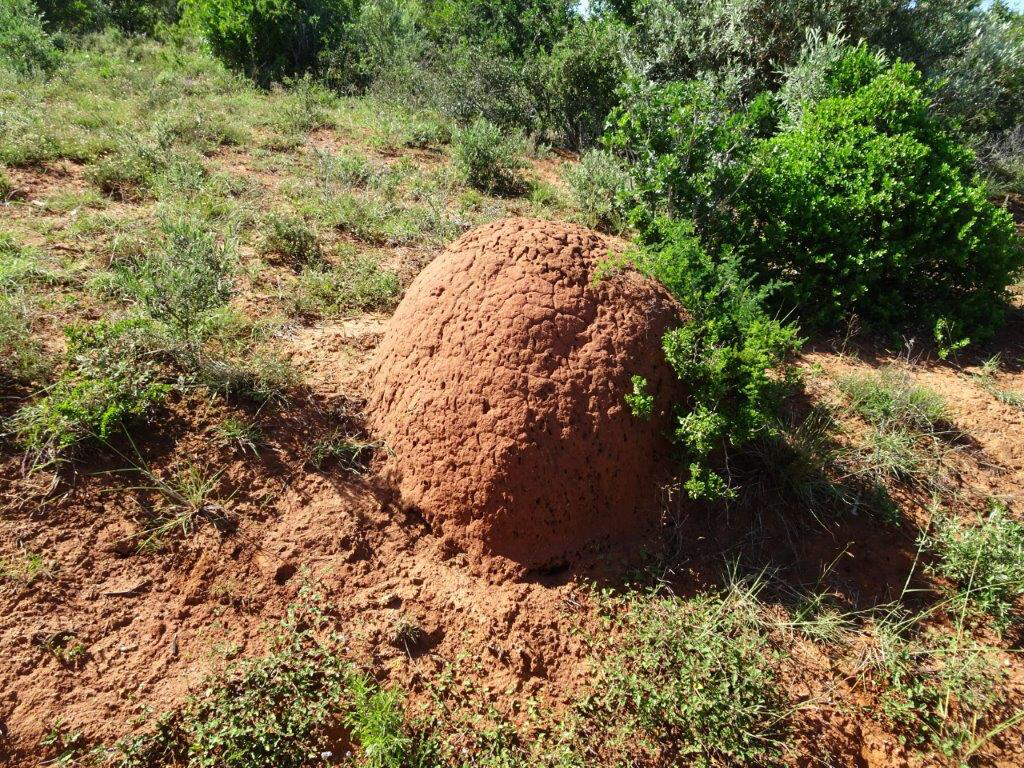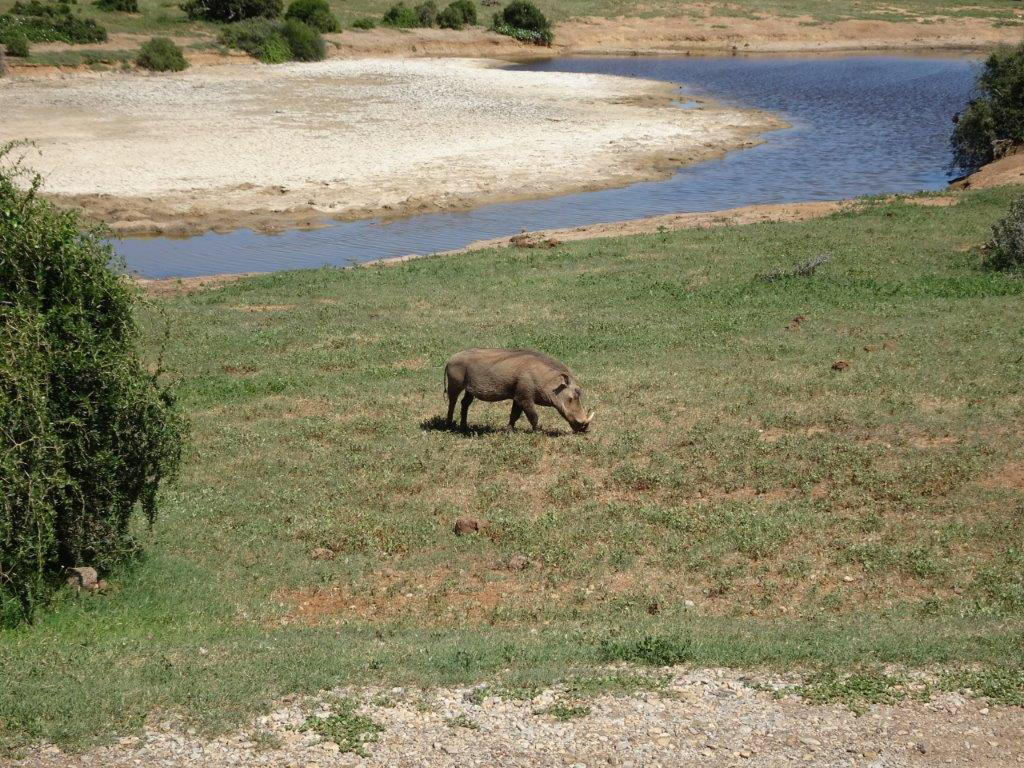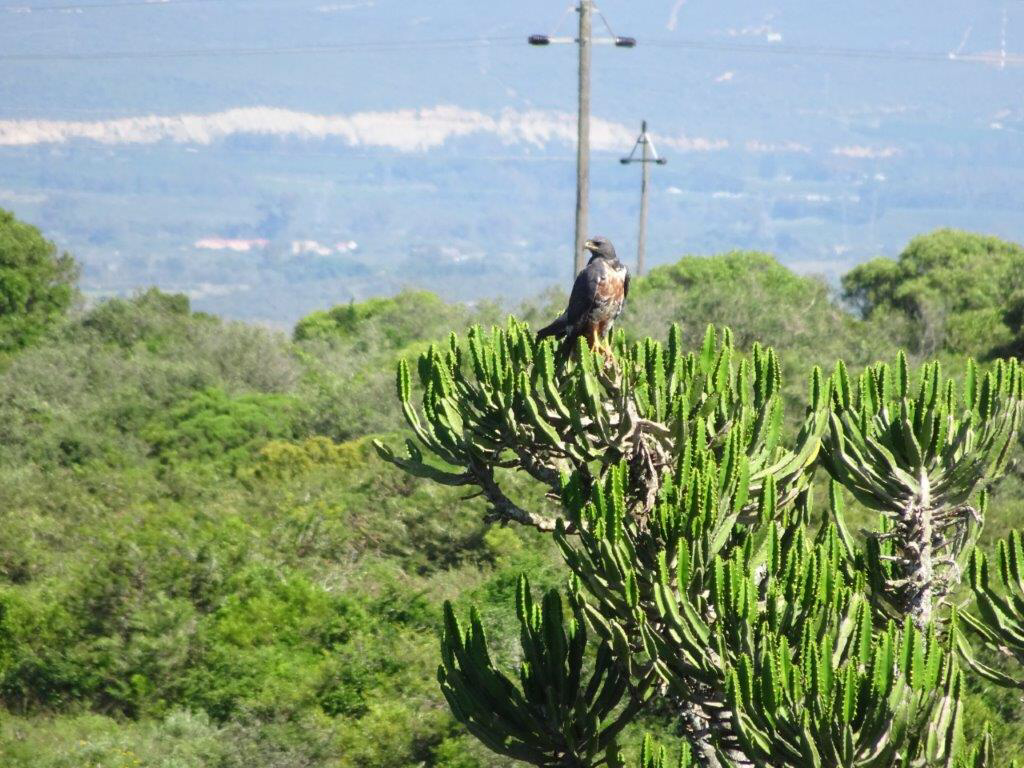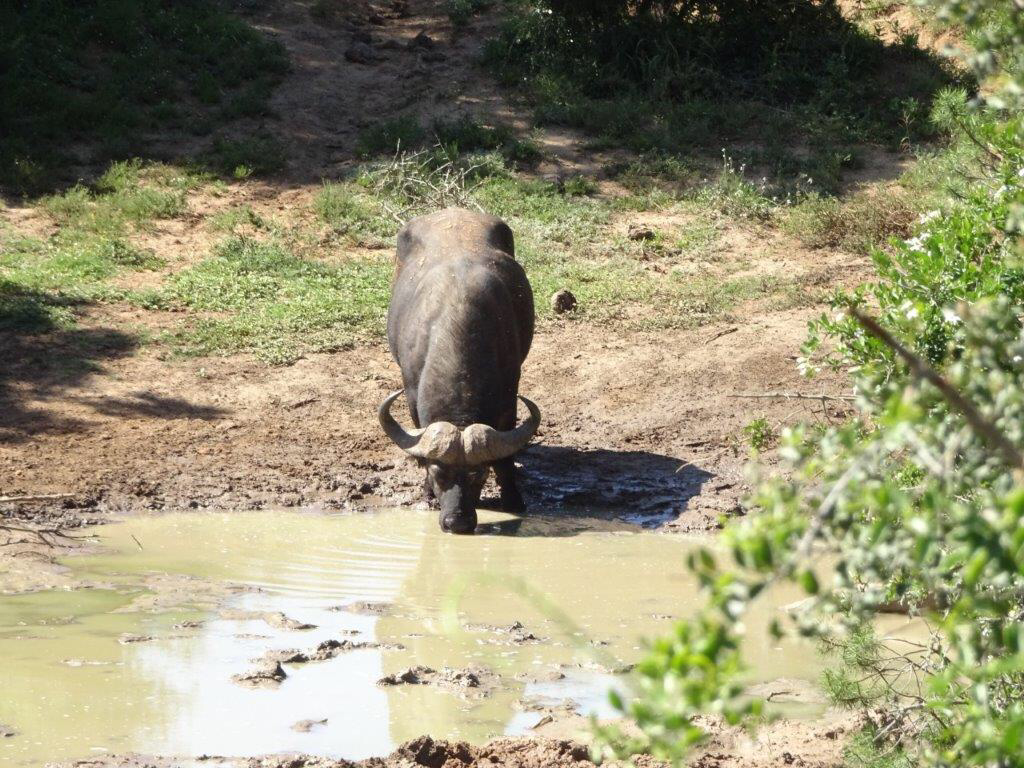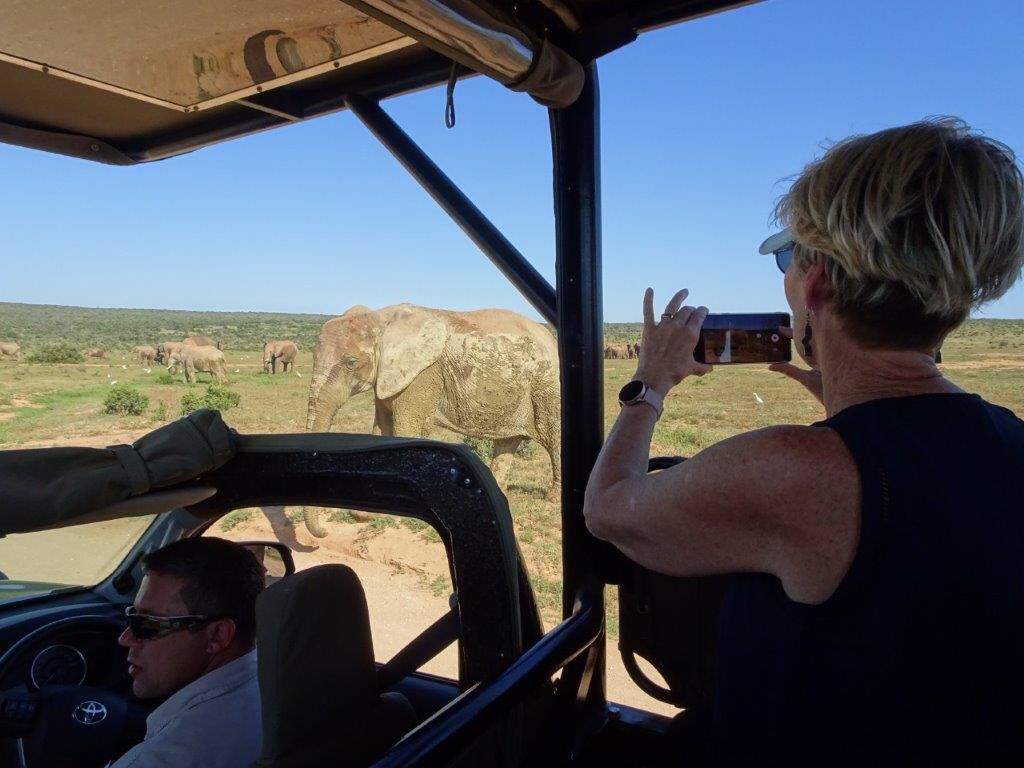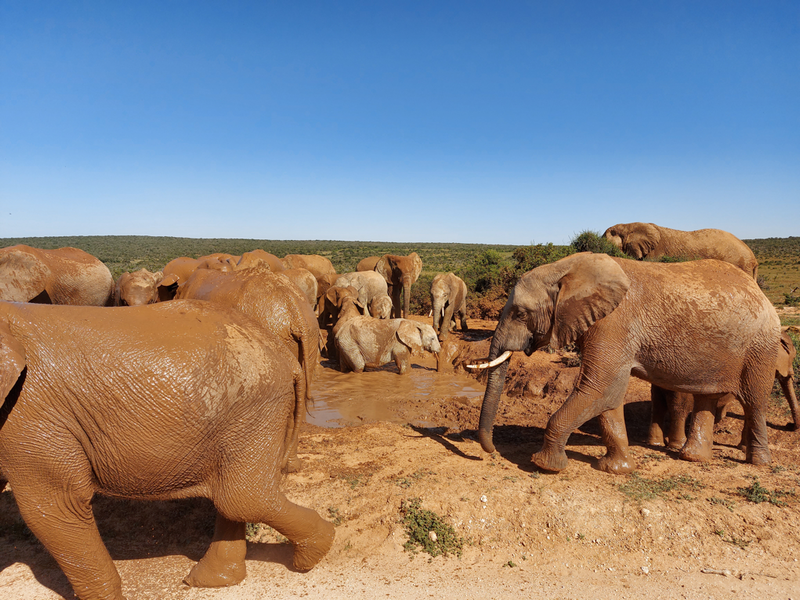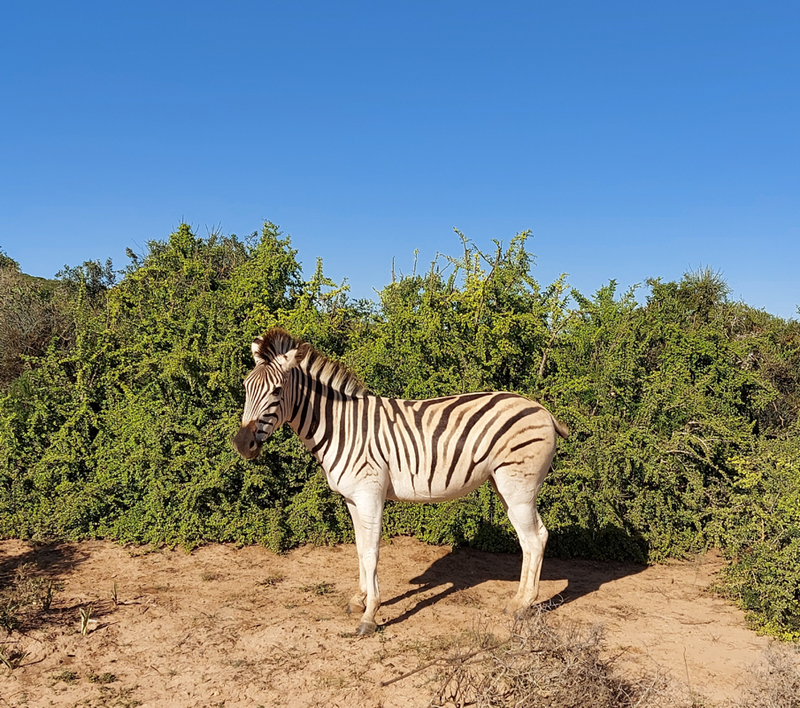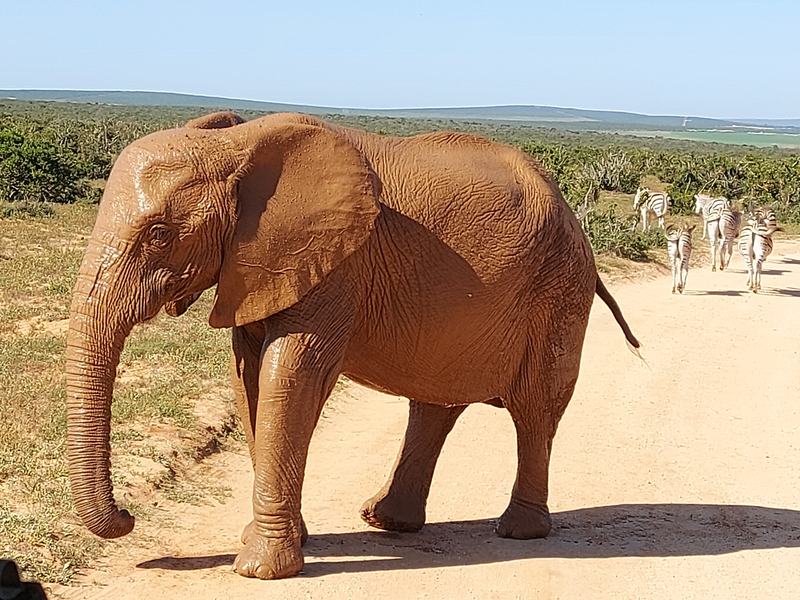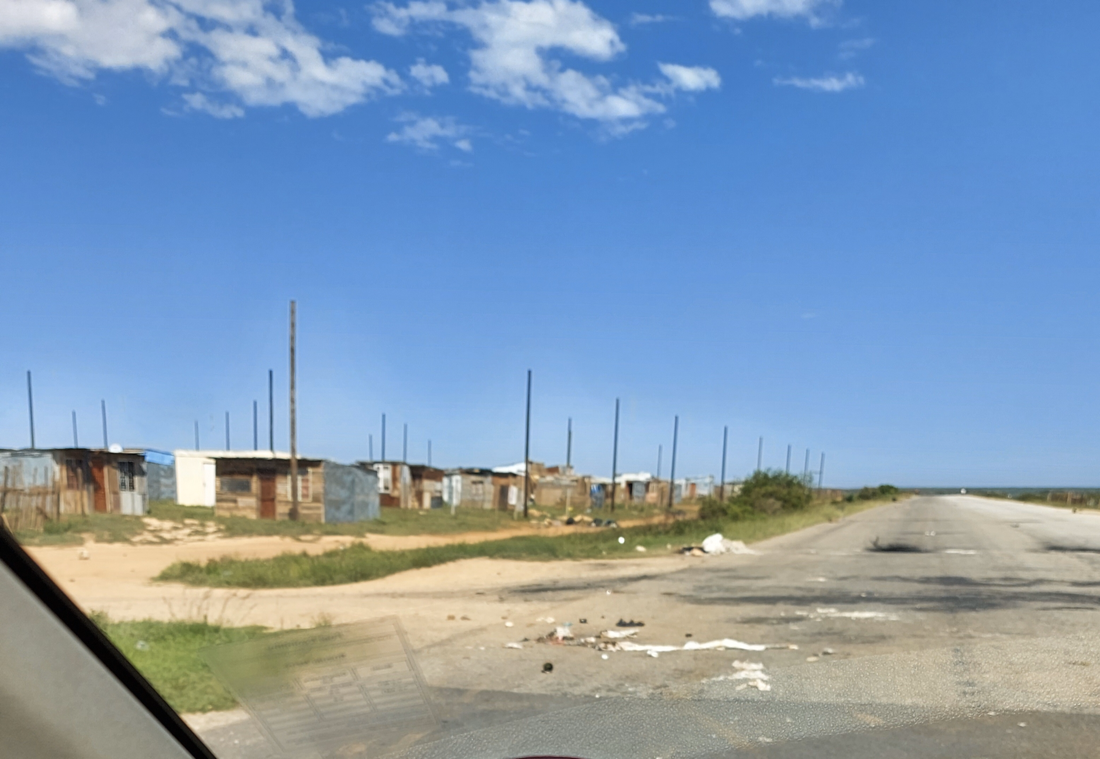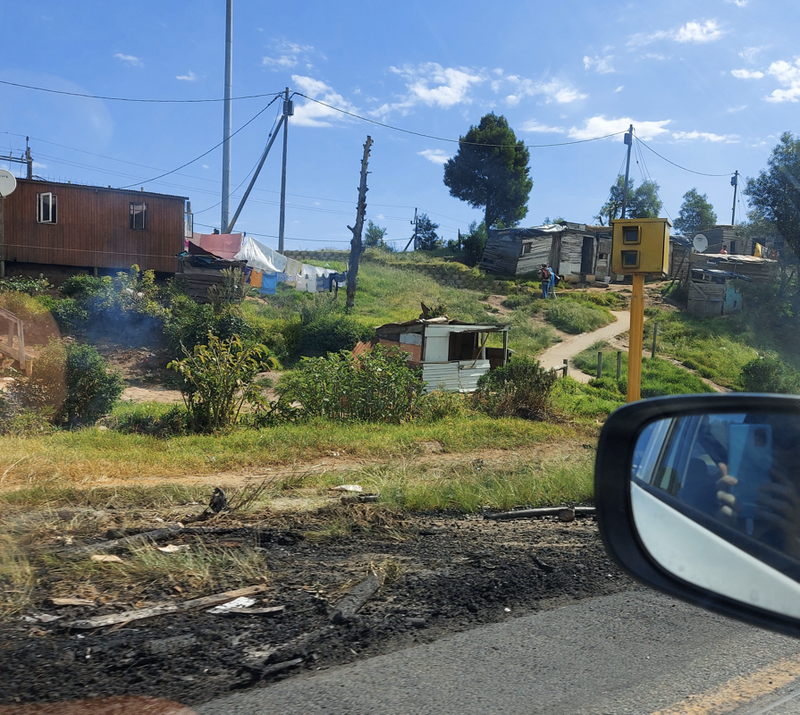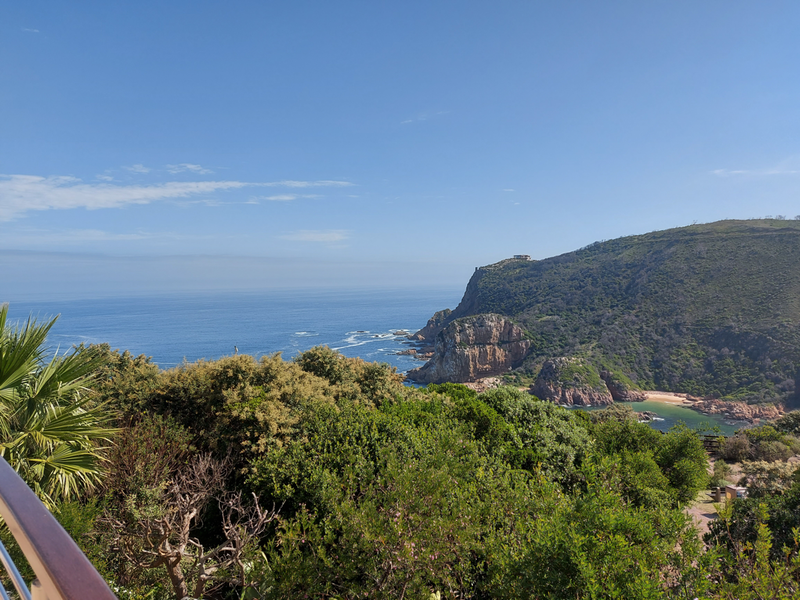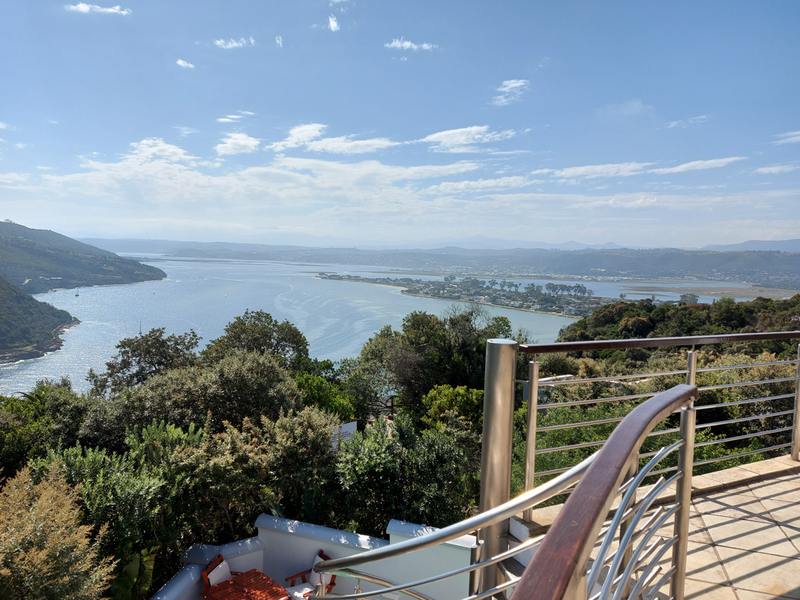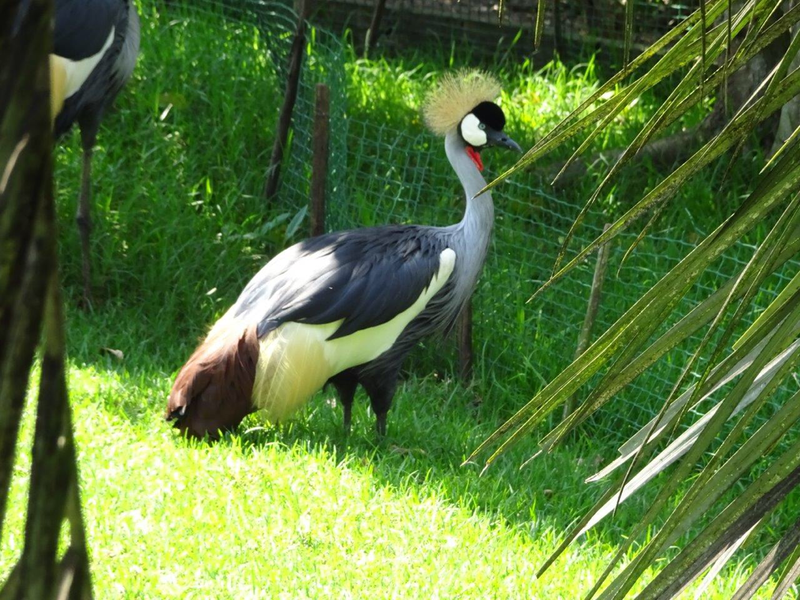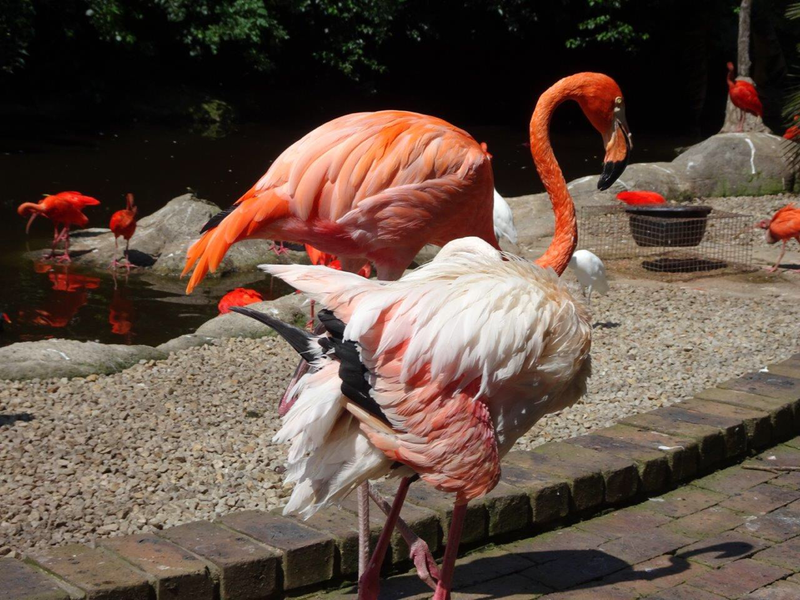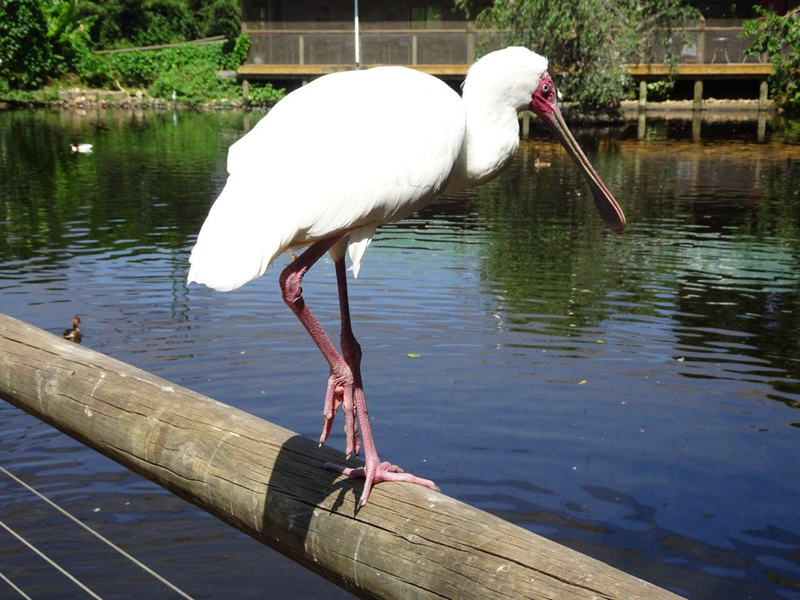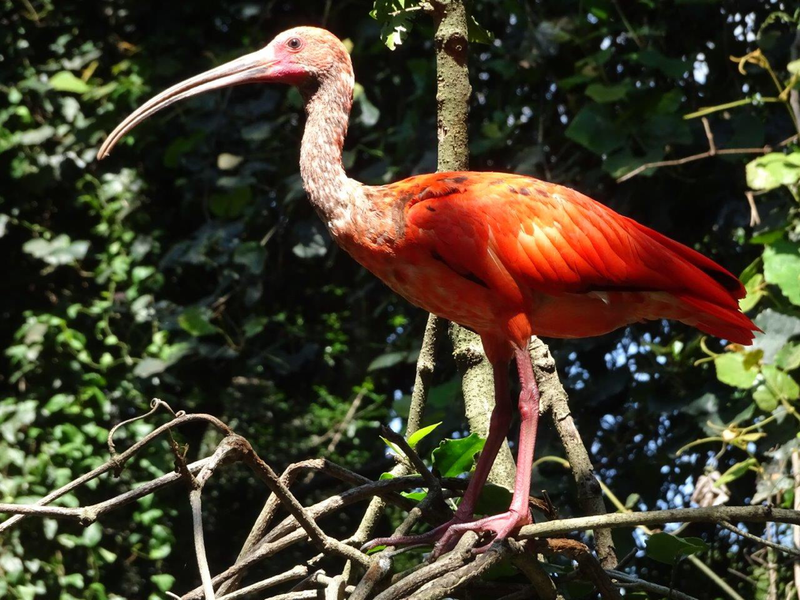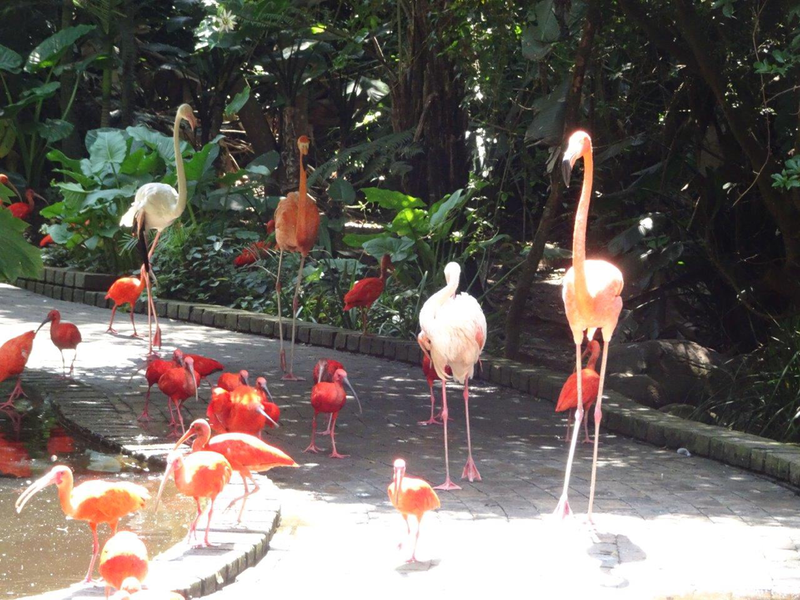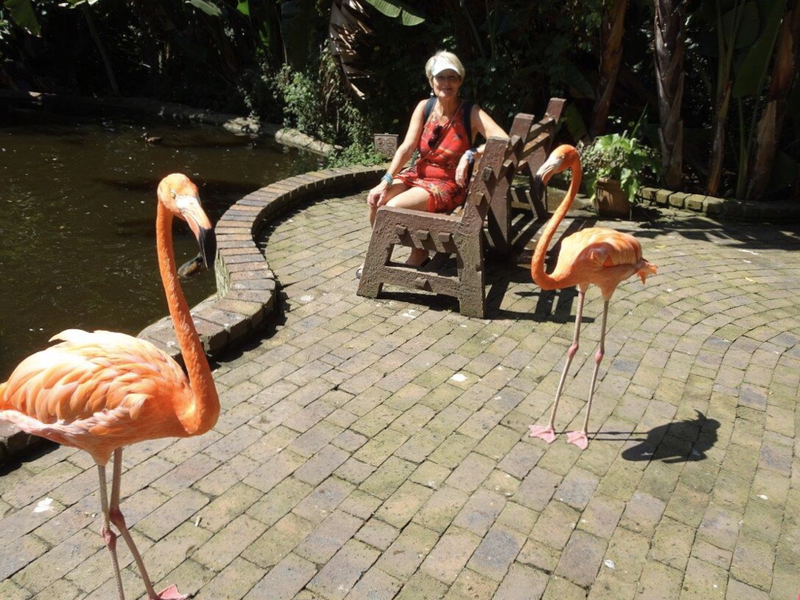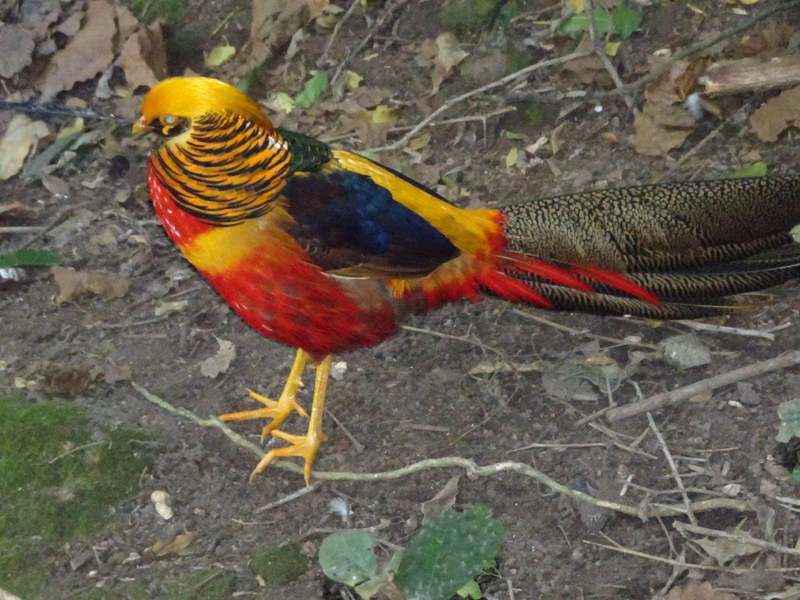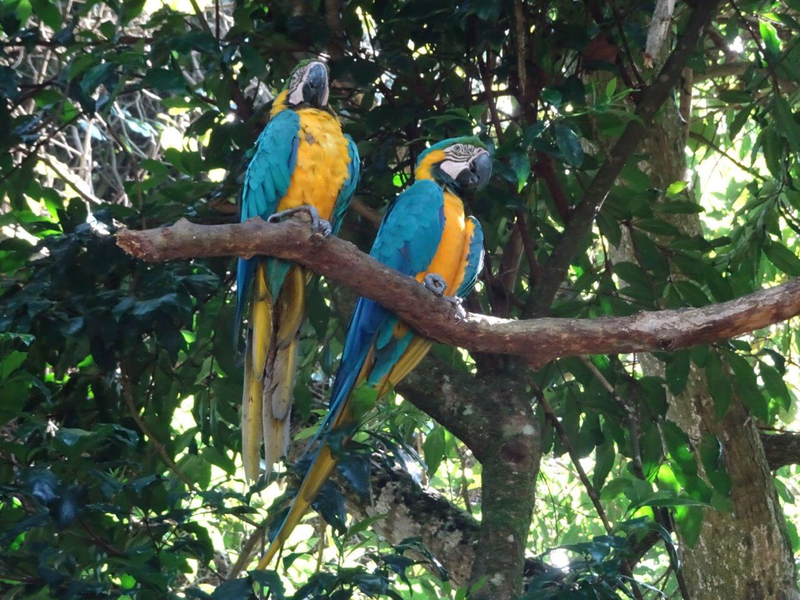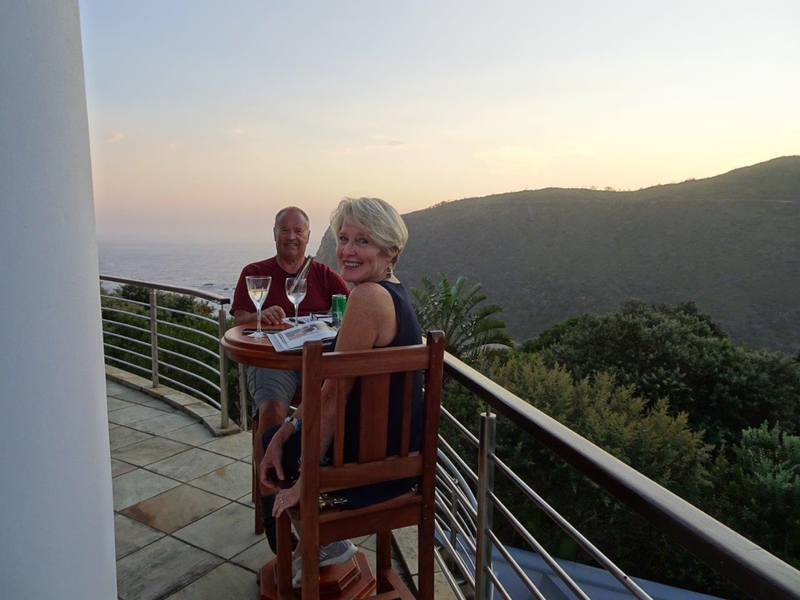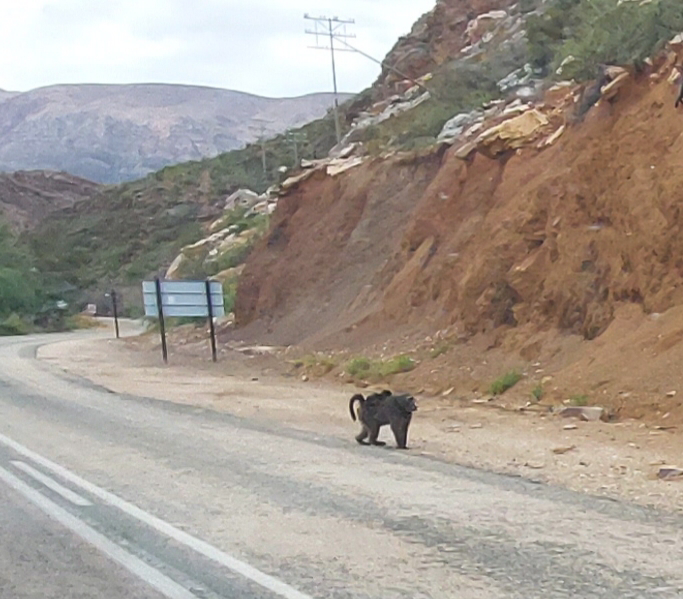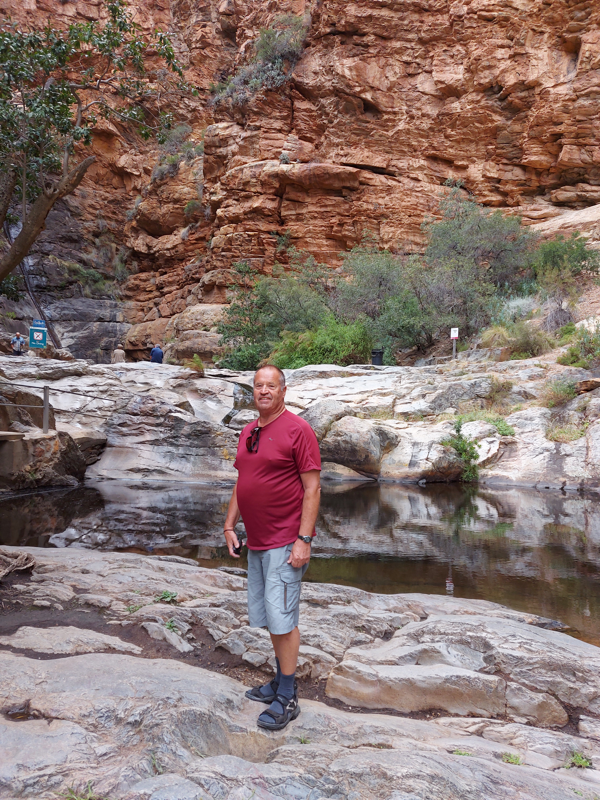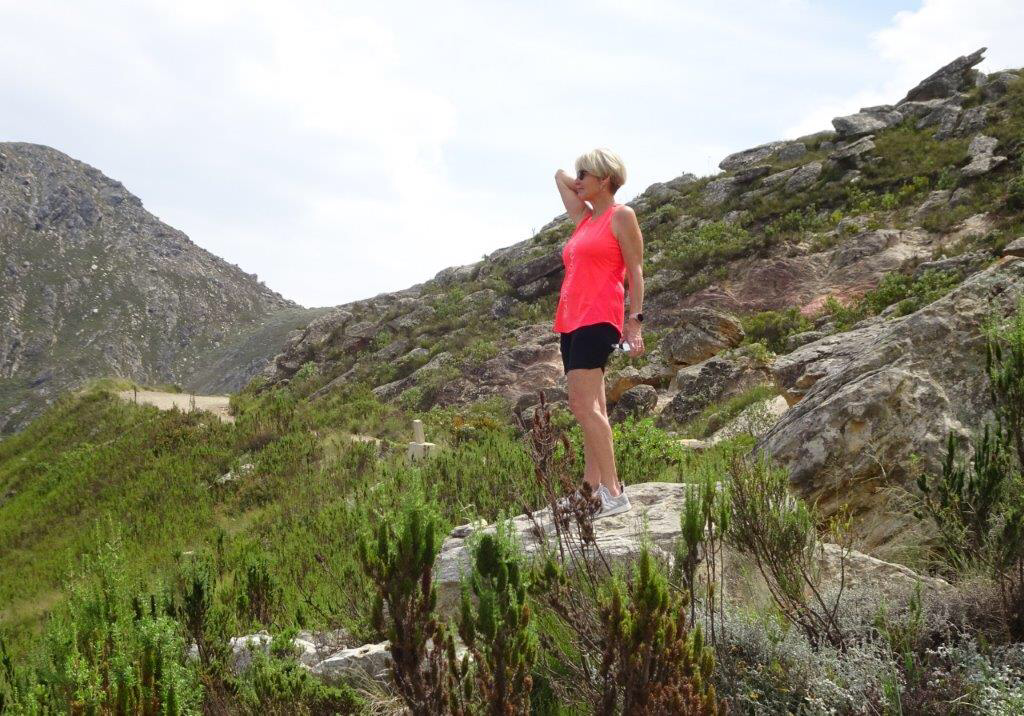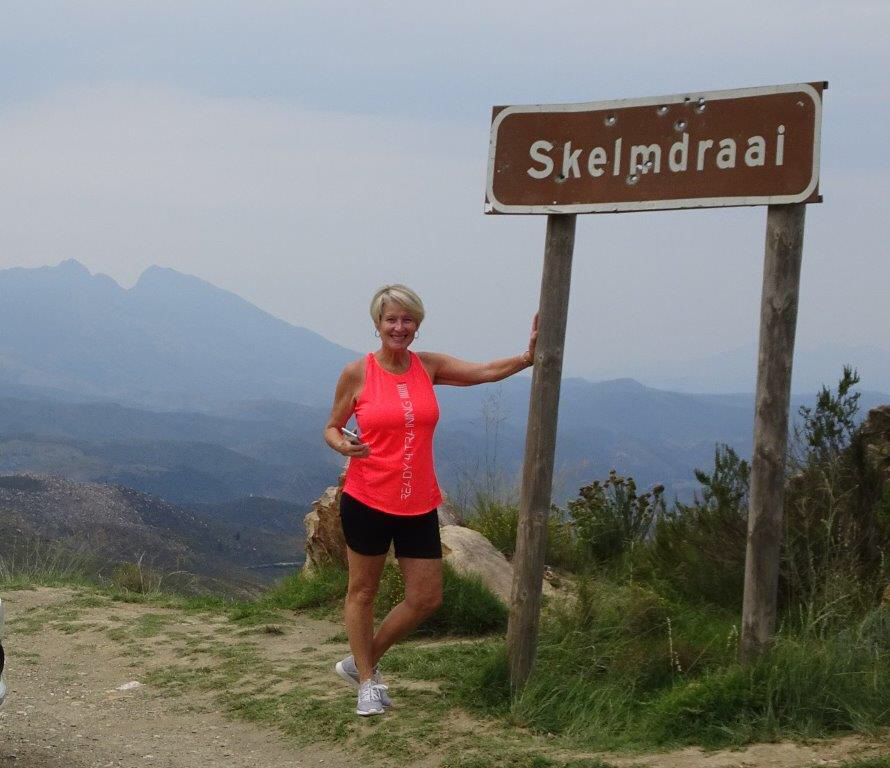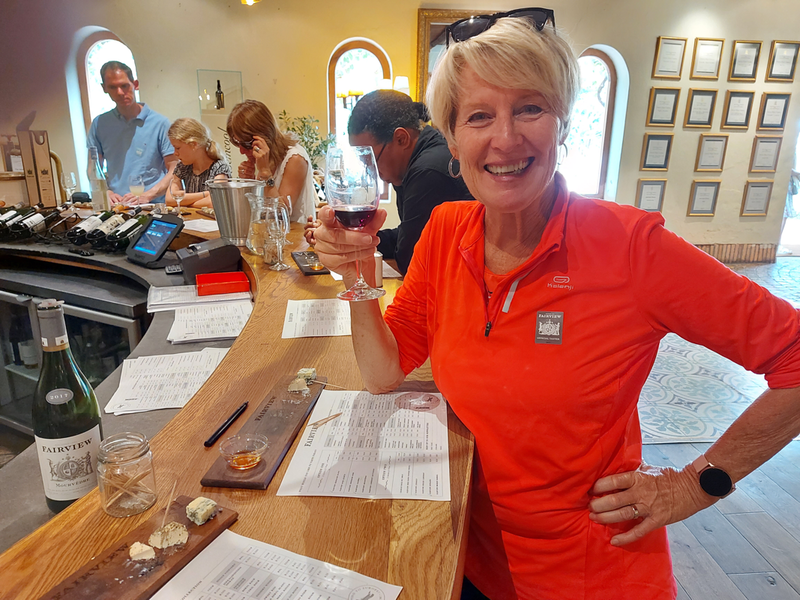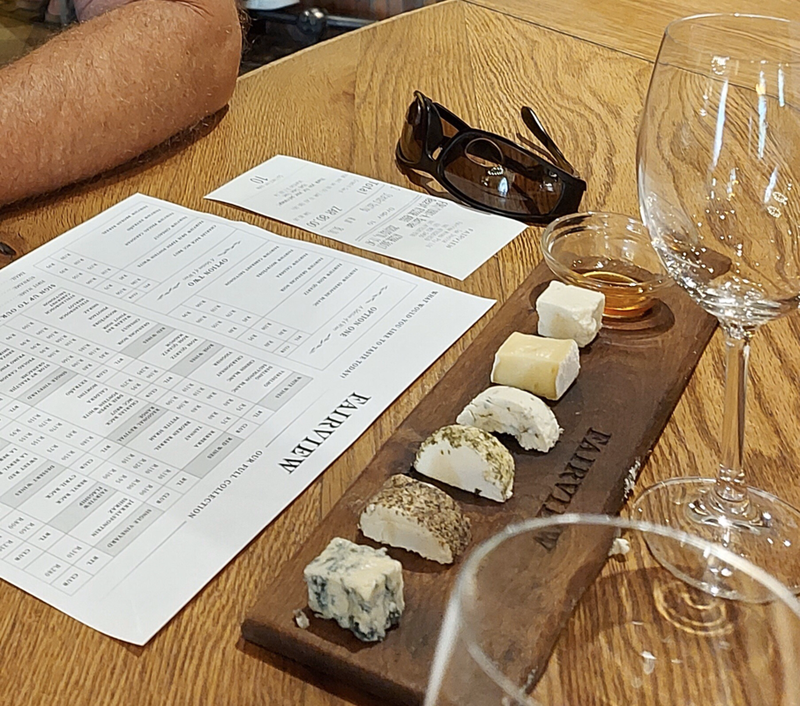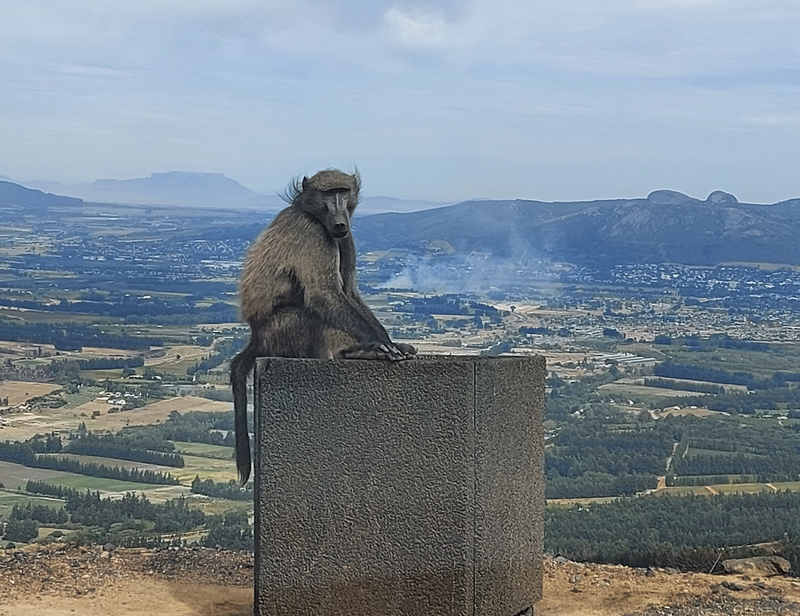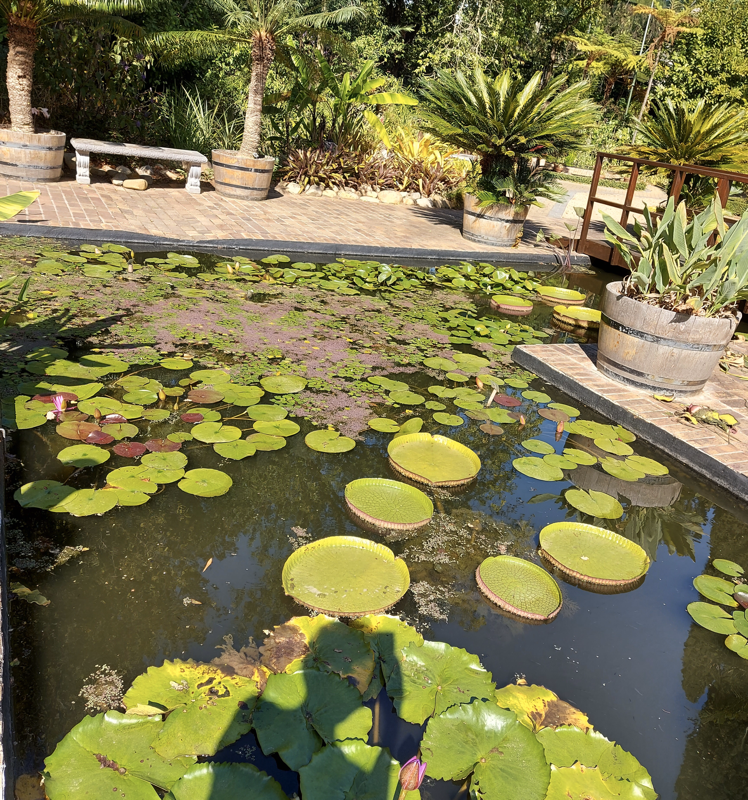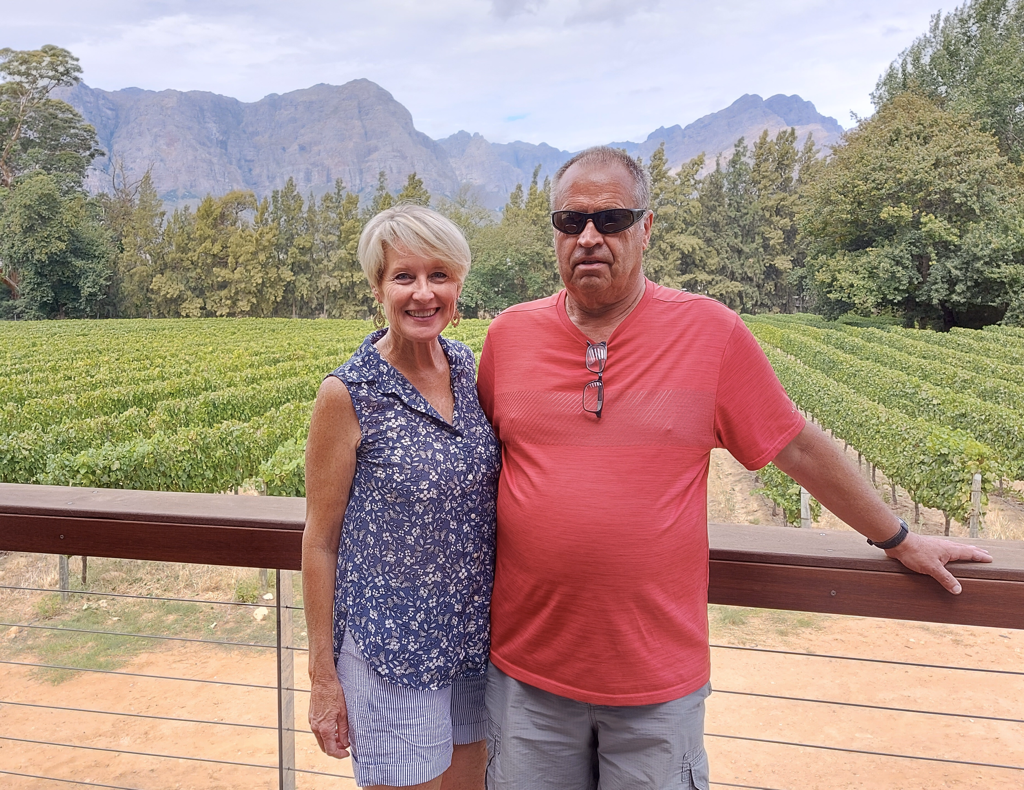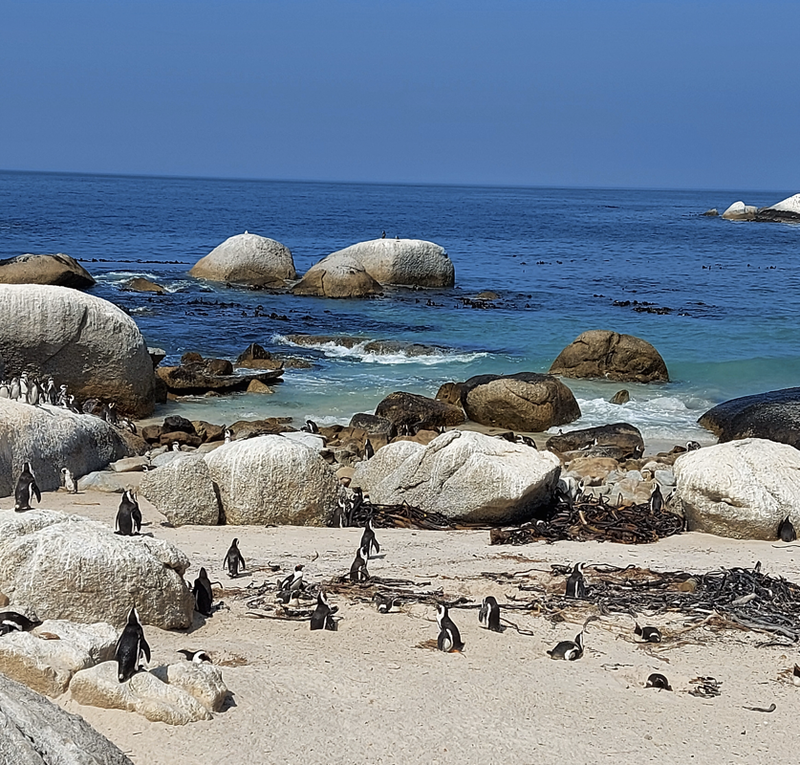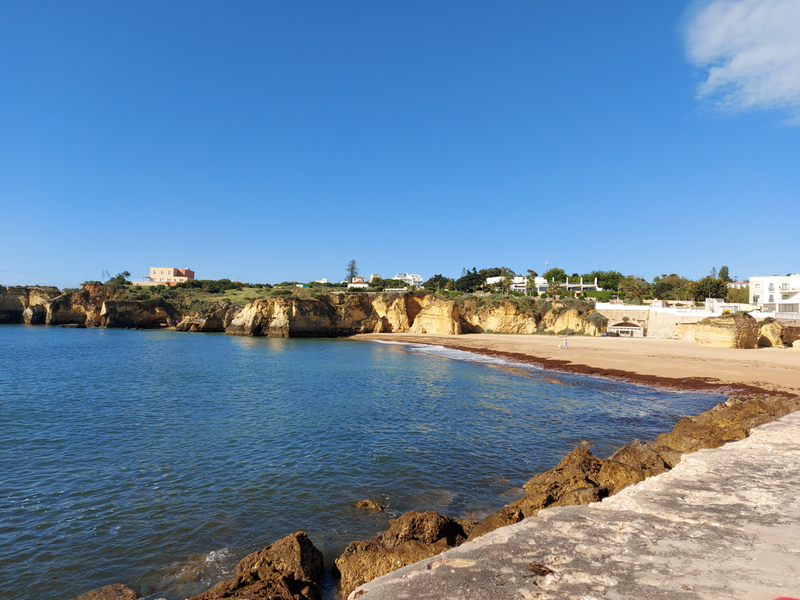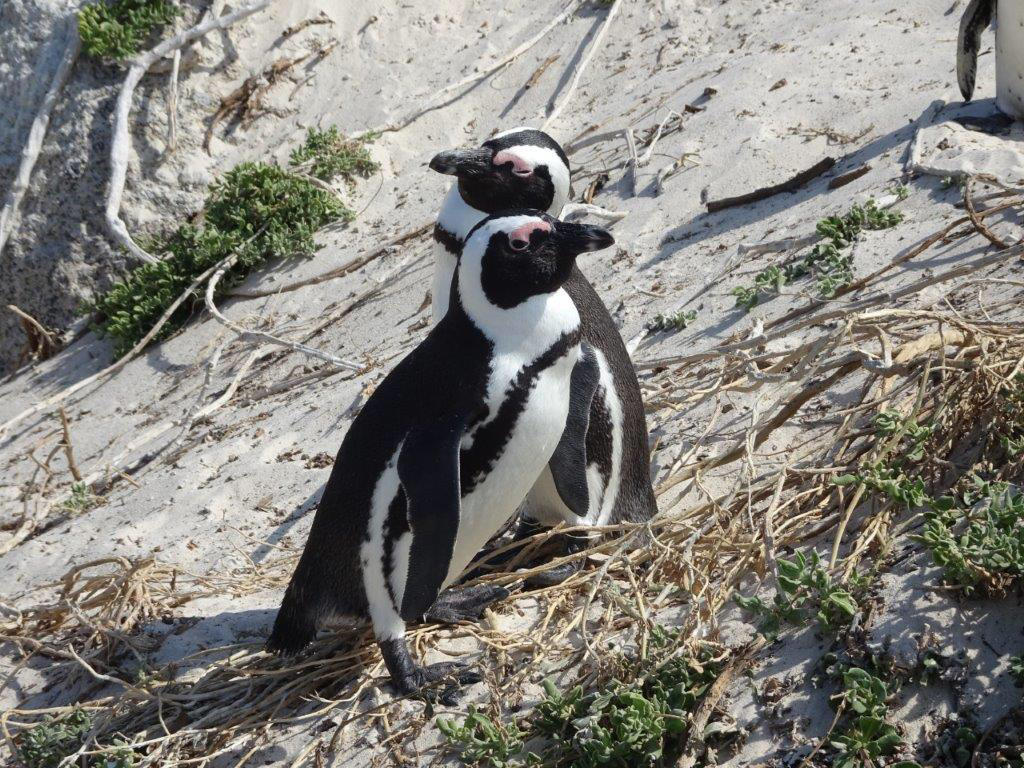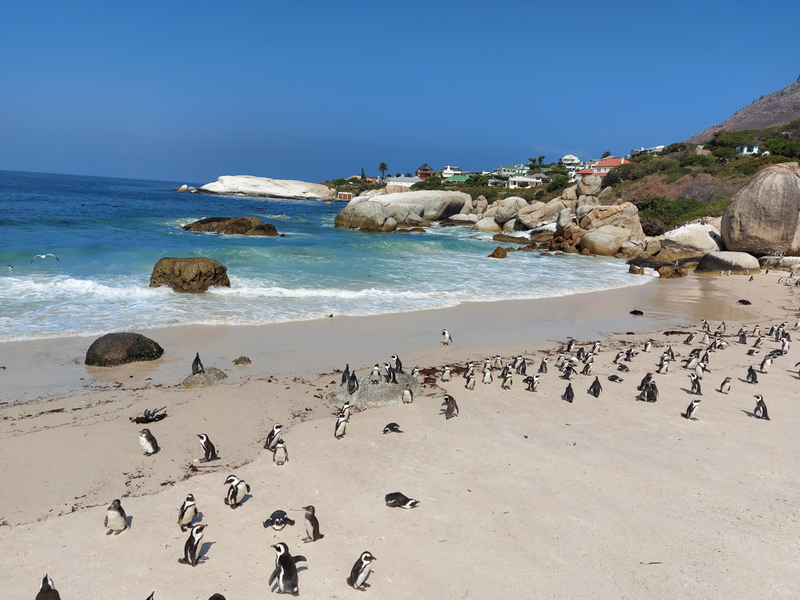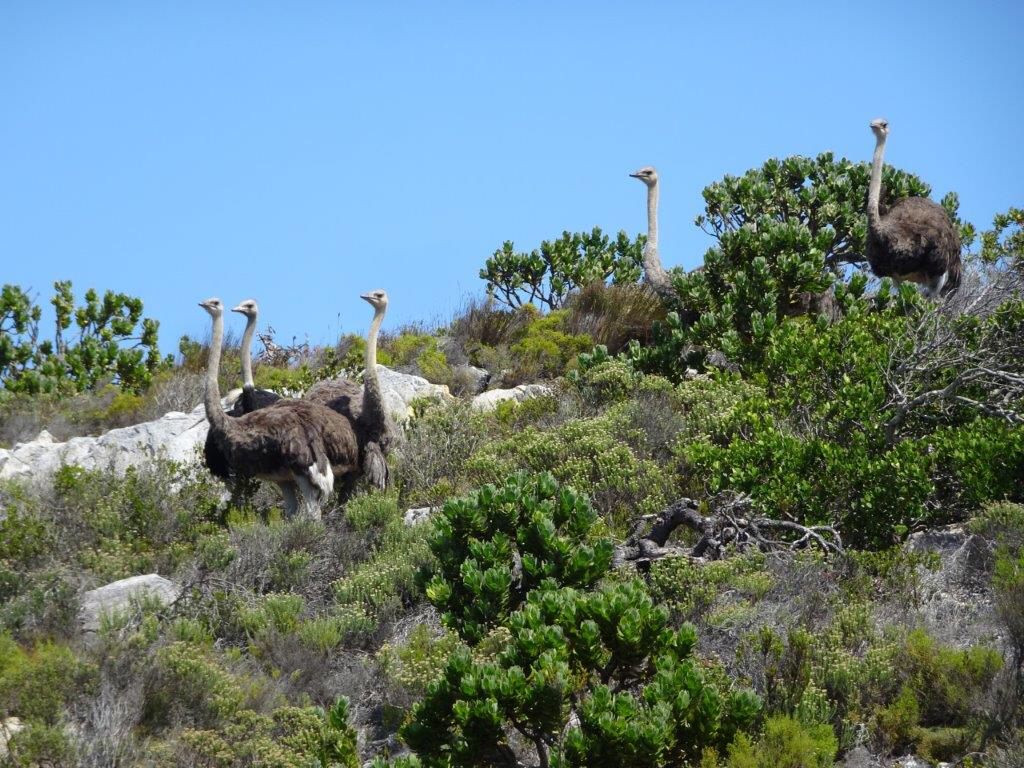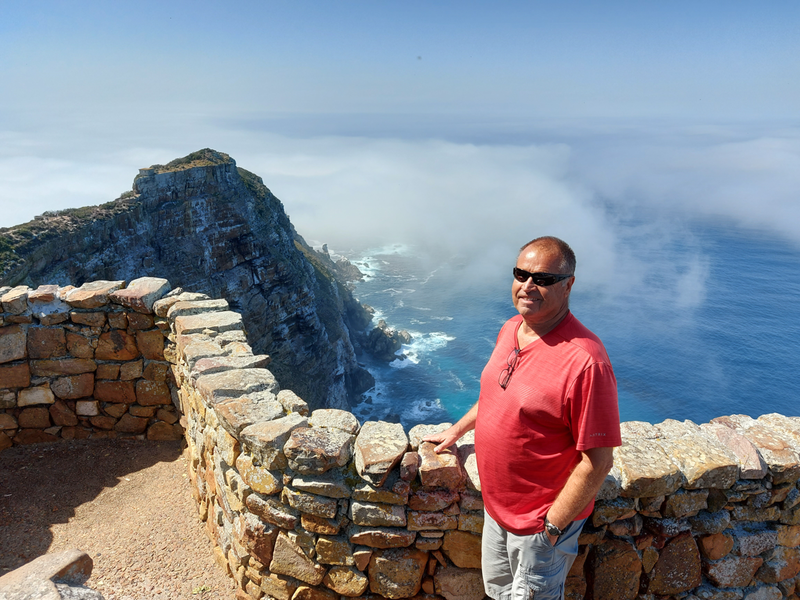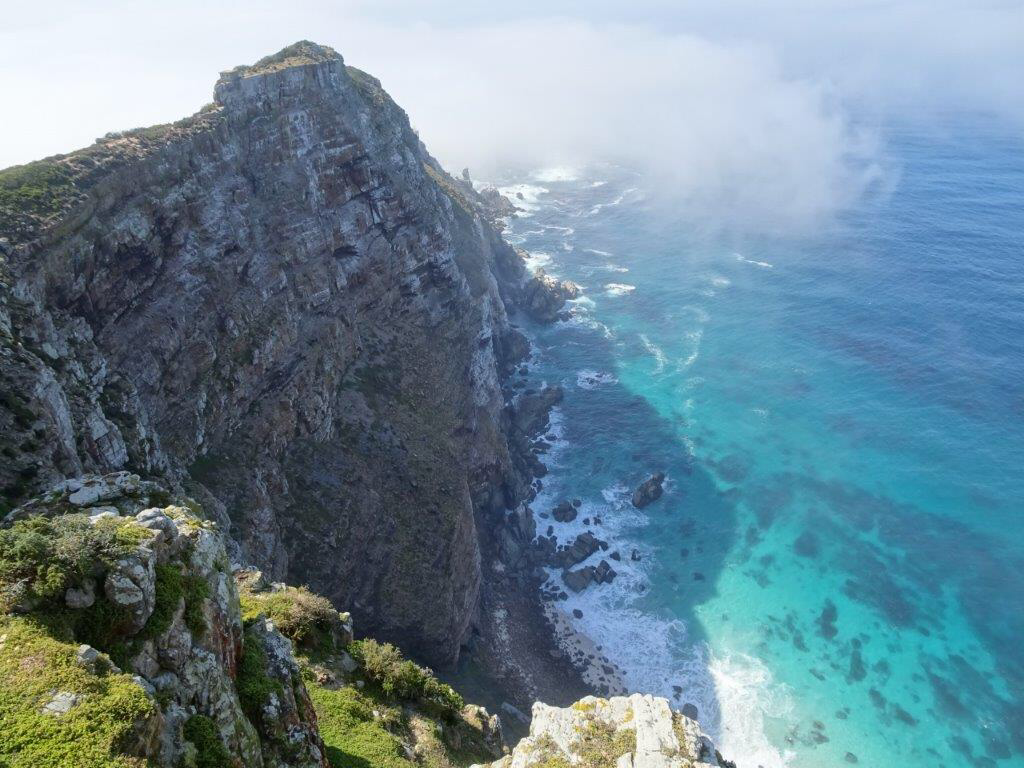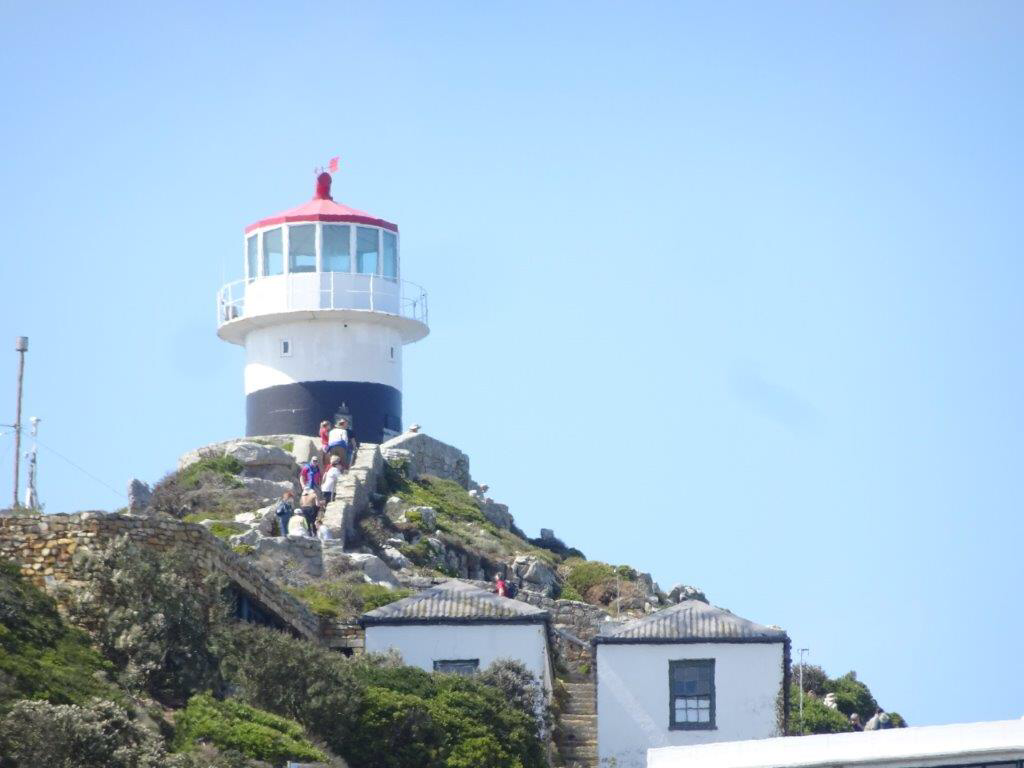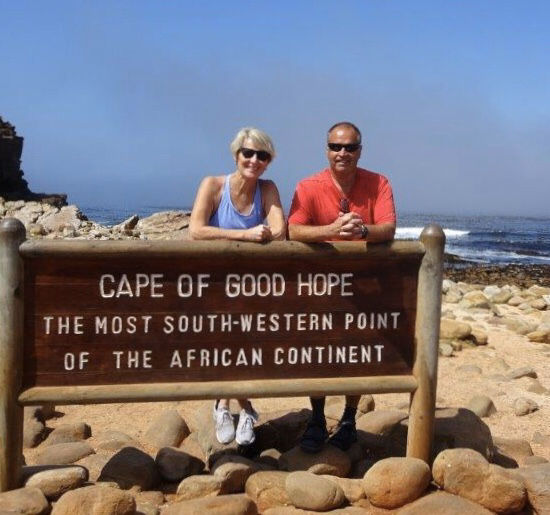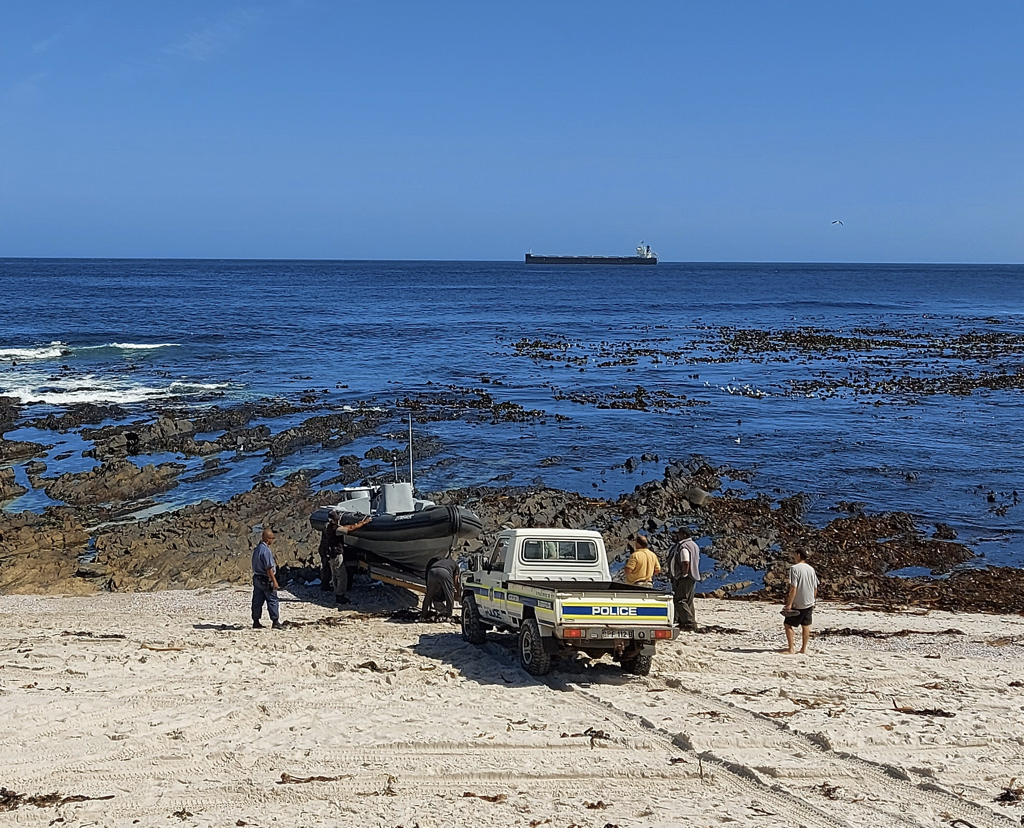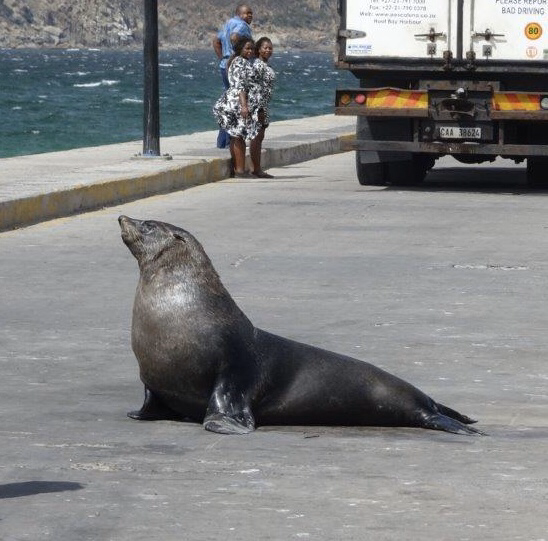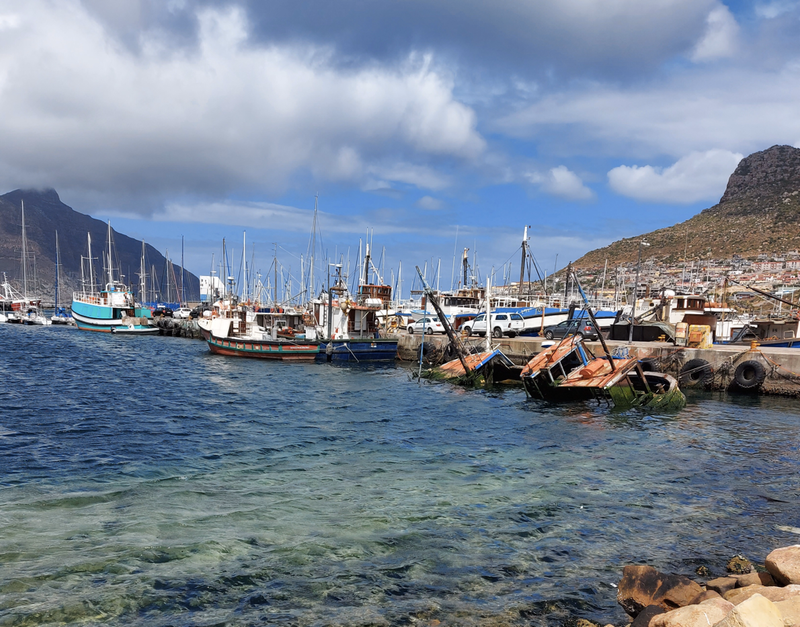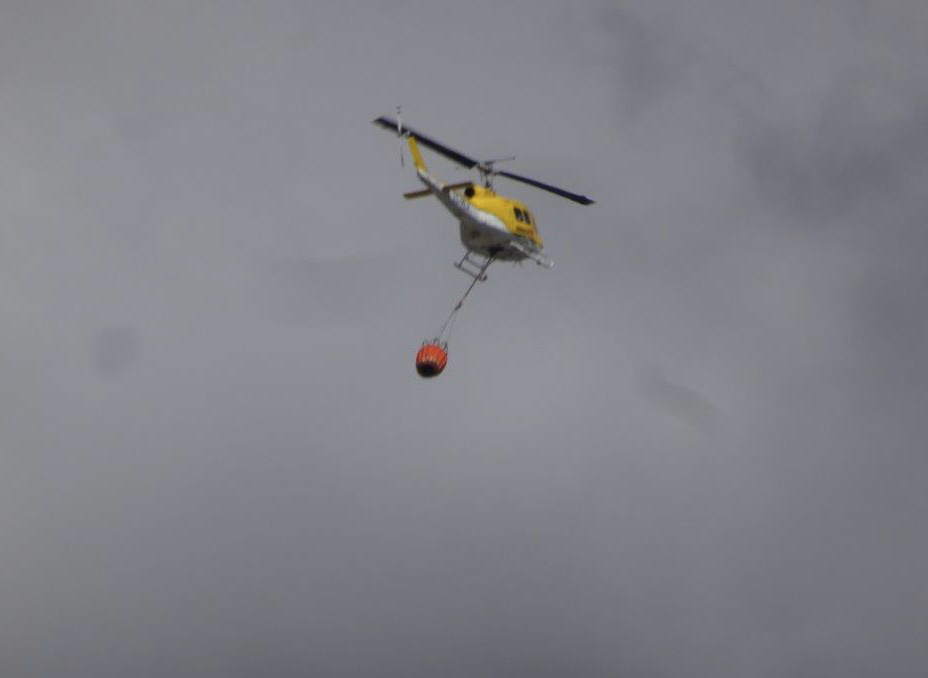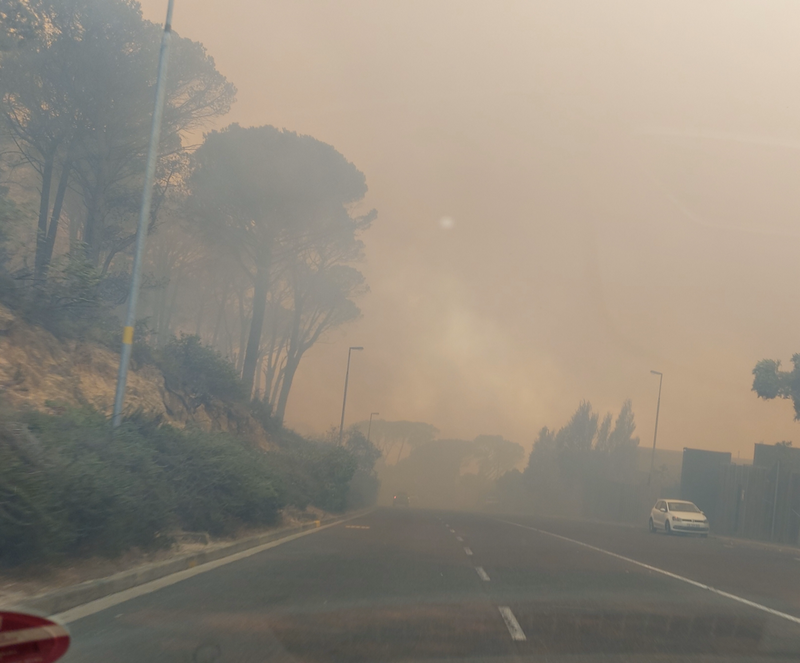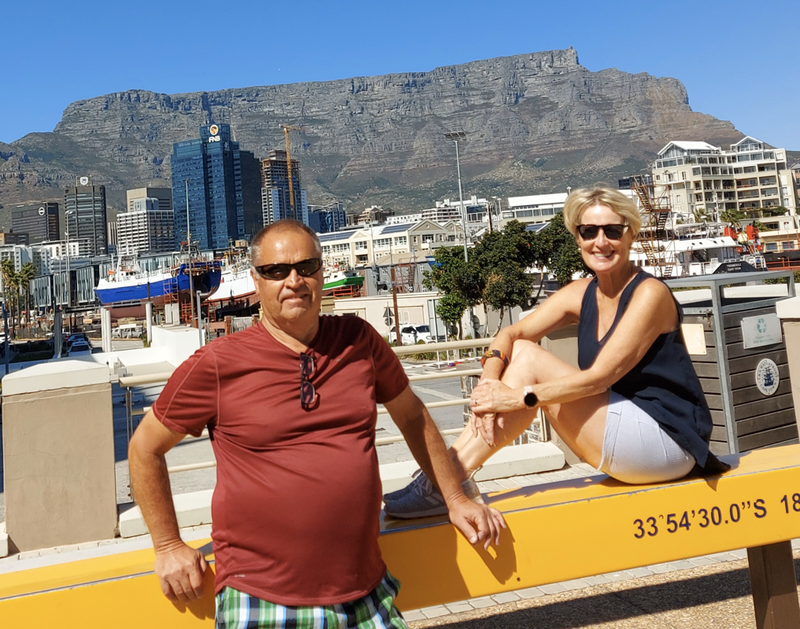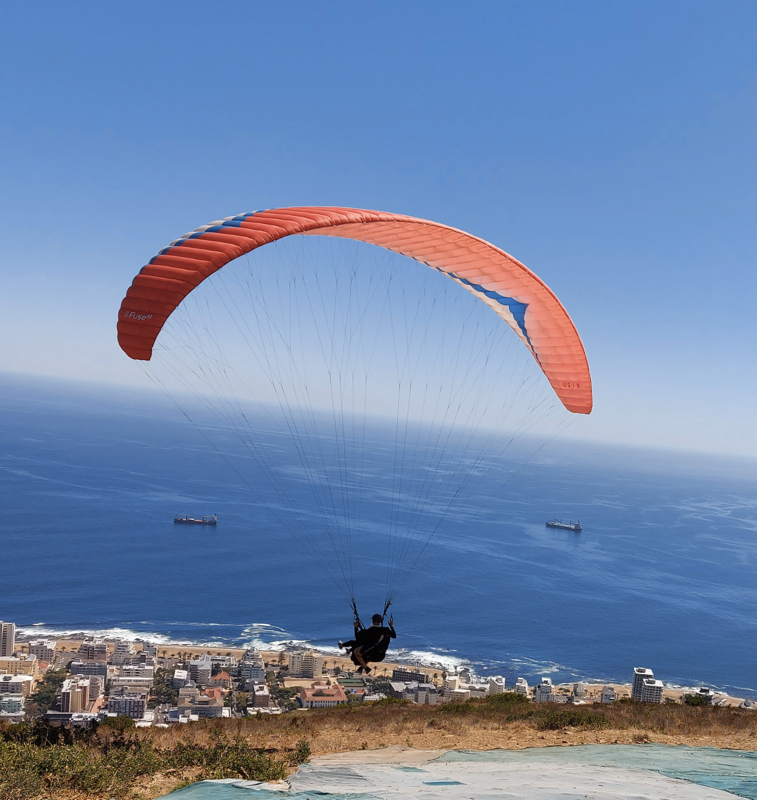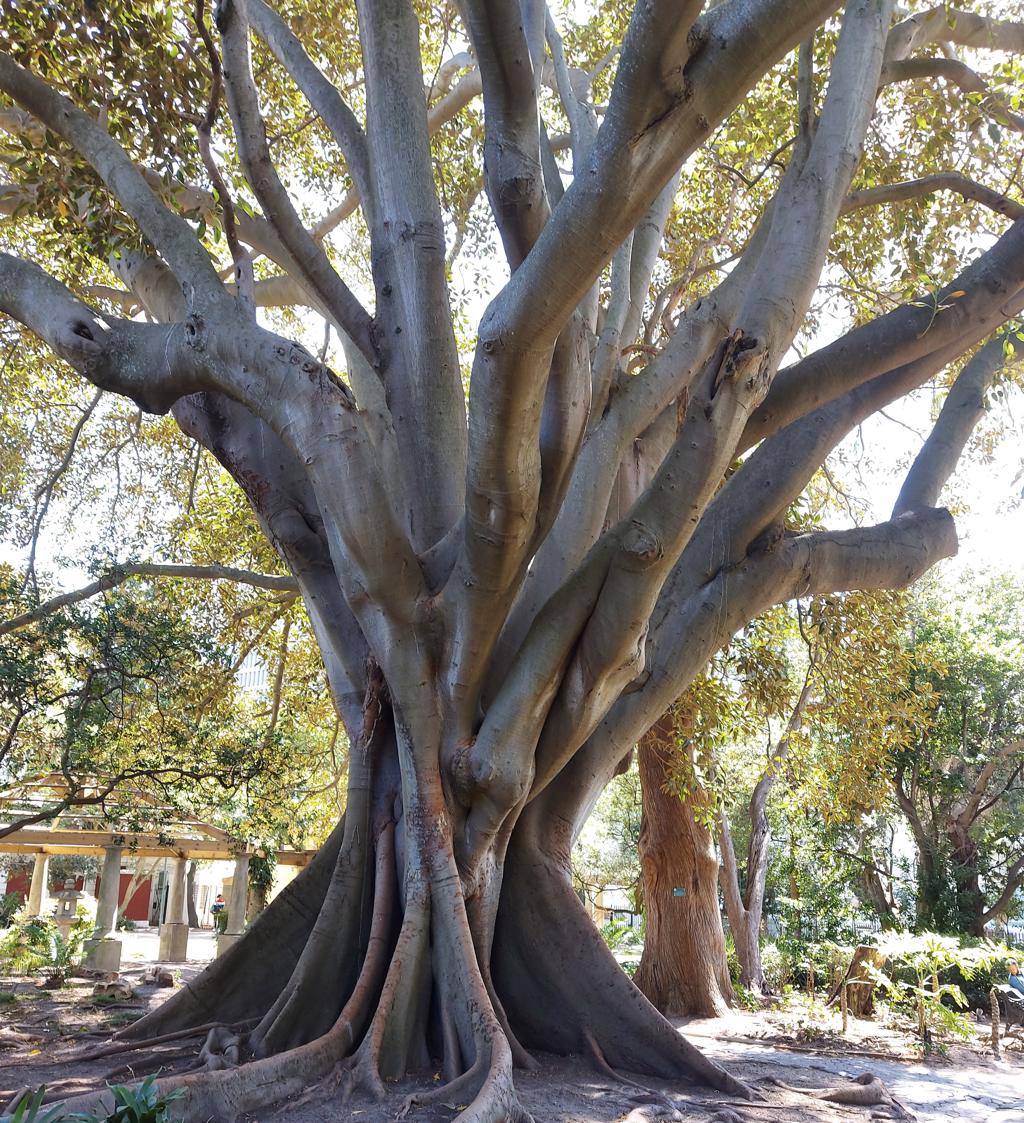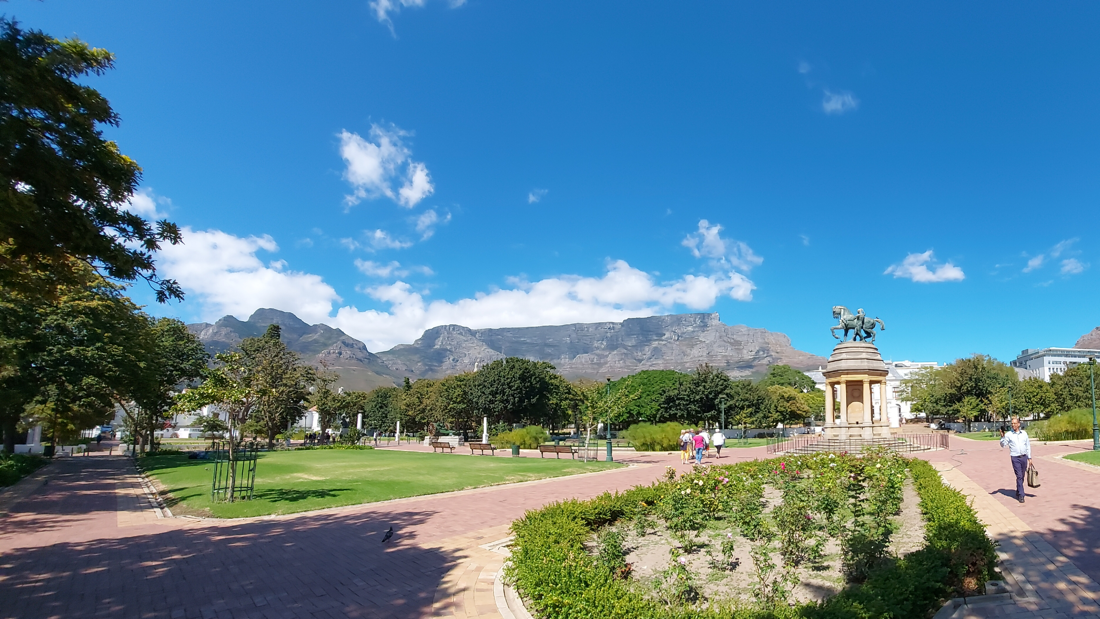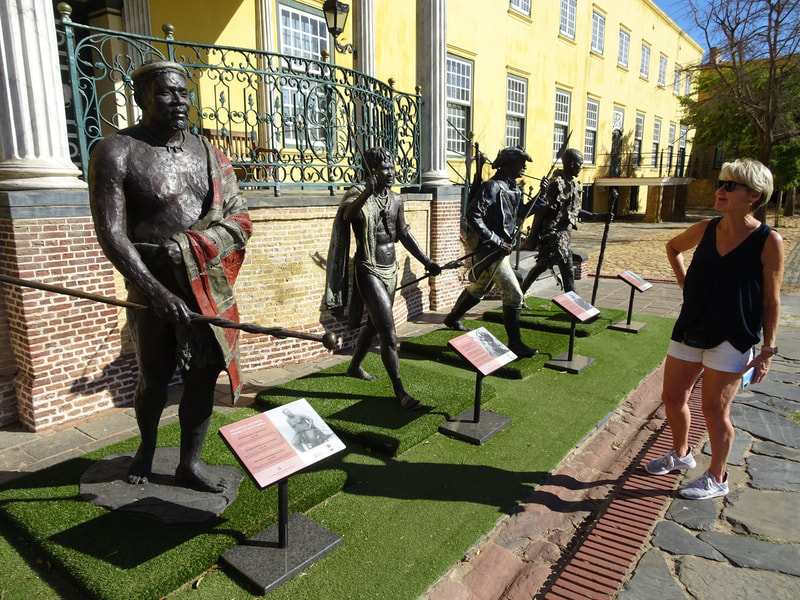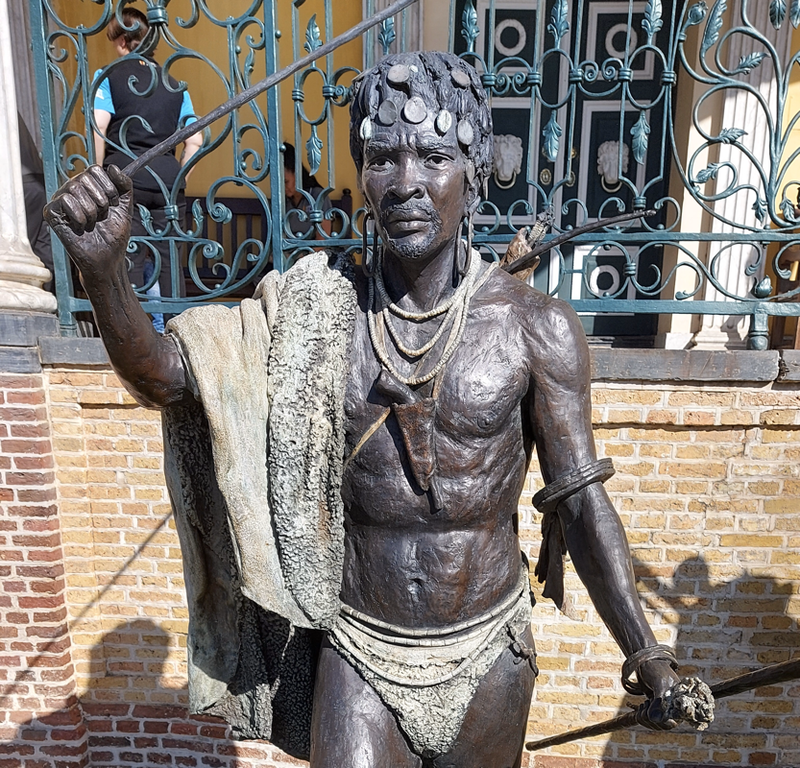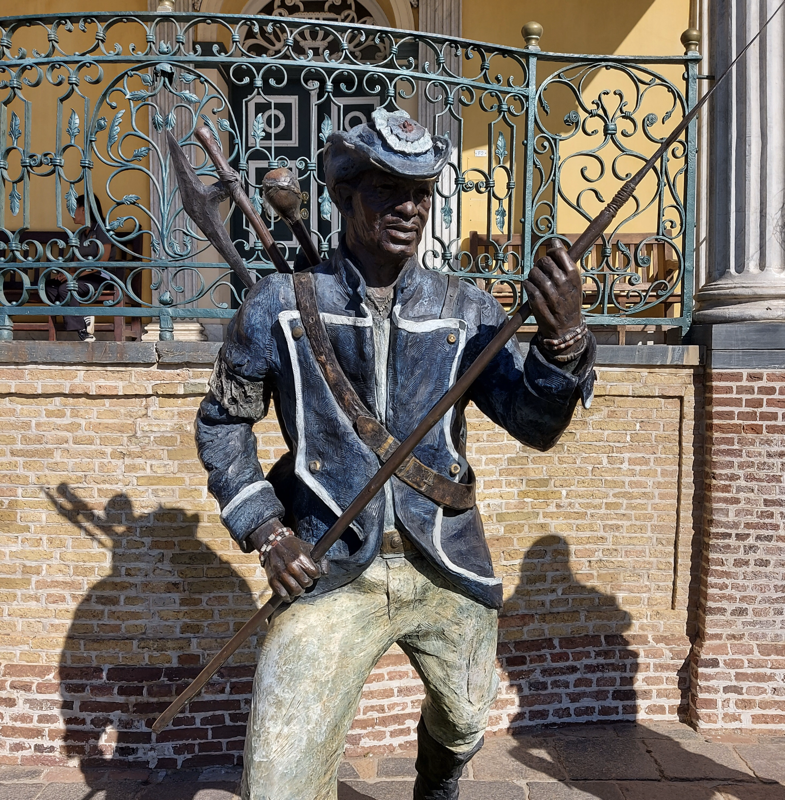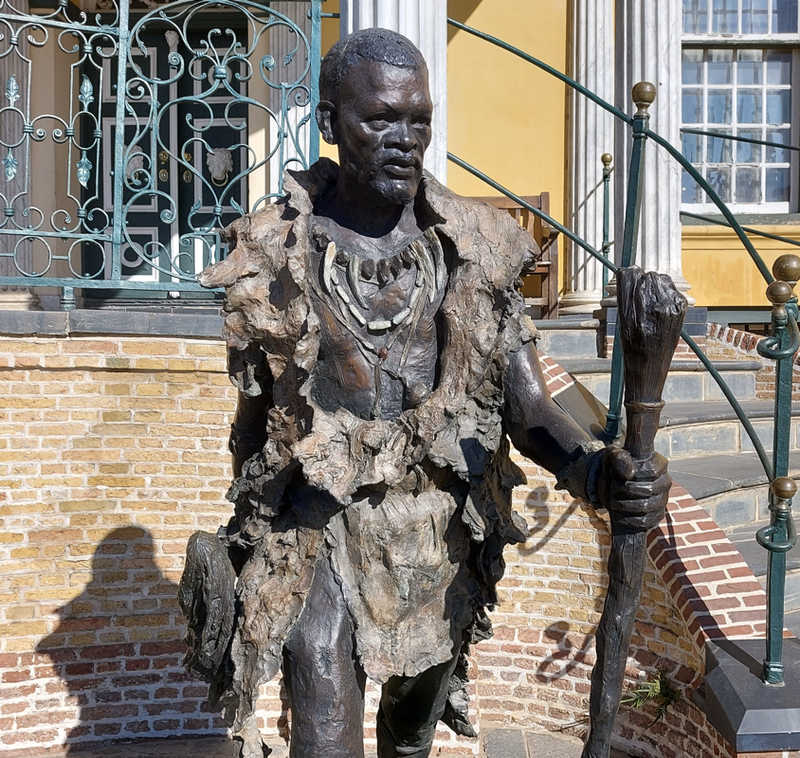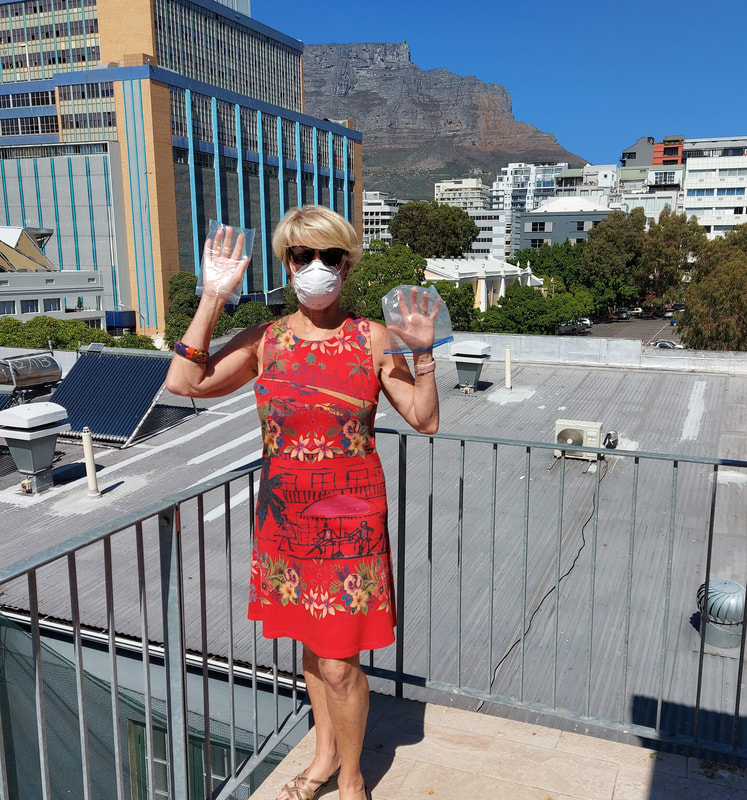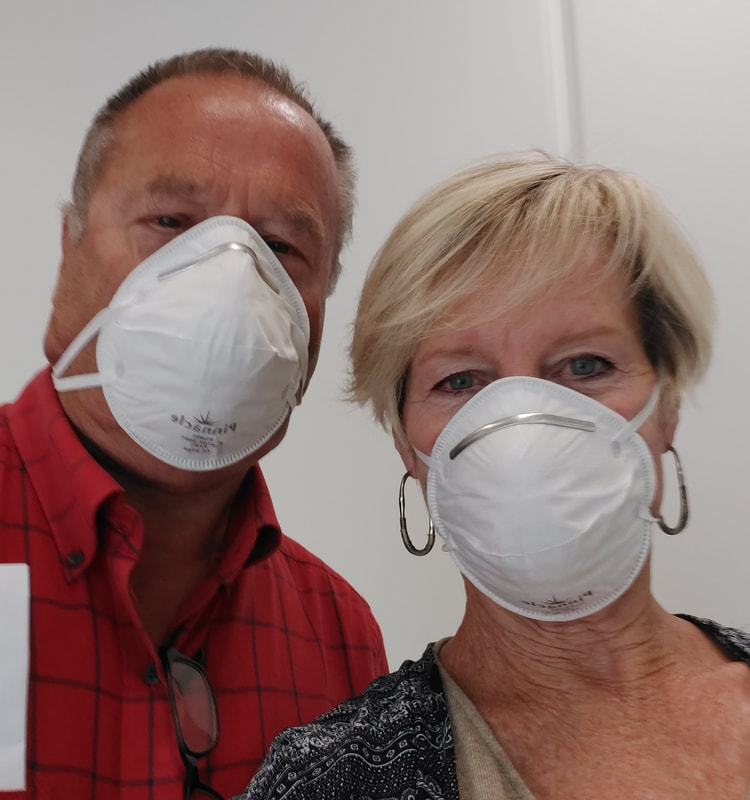|
February 22 - March 23, 2020
With five months left before taking possession of our beautiful home in Carvoeiro, Portugal, we arranged a self-guided tour of South Africa, a new country for us. Our flight touched down in Johannesburg where we collect our car and begin our journey from one end of the country to the other, ending abruptly with a narrow escape when COVID-19 nearly locked us there. |
February 24 -- We entered Africa, a land mass accounting for one quarter of Earth’s land surface. Our visit will take us to the top and to the bottom of South Africa. Our two-day journey (18.5 hours by plane with a 2-hour layover in Qatar), touched down in Johannesburg at 10:30 am. Totally surprised, landing in Johannesburg, people boarded wearing white gowns and masks taking everyone's temperature before anyone could disembark. Once in the airport, we received two more body temperature checks for the coronavirus. We then collected our British-driving Suzuki rental and began our journey toward the gorgeous Drakensberg Mountains, however, first stop was the Vodashop for a SIM card and then the instant teller for Rand bills.100 rand = 10 dollars Canadian.
February 25 -- At the Little Switzerland resort, we selected their “easy” hike which went nearly straight up to the “Cone” a precipice above the chalets. Red-backed grass hoppers hopped aside as we passed. Birds sang and buzzards cawed. There wasn't another soul in sight.
The next day, we drove to the Sani Pass Resort, exiting the toll highway for fuel. Going through the exit at 40 KPH I shouted, "STOOOOOOP!" Con slammed on the brakes still moving through what was a moment before a closed barrier across our lane. It miraculously lifted missing our windshield by a hair. Neither of us saw it. Either the attendant realized we weren’t stopping and hit the “up” button, or we have angels in the car with us. After filling up, we decided to take the secondary road through the cattle and corn country. Once we were at the half-way point with 67 km to go, the road nearly became impassable. No other vehicles drove the route, however we passed a couple of tractors. We challenged fate (and our tires) with the boulders, hugging the Drakensberg cliff edges, dodging potholes, and crossing narrow bridges over fast-flowing rivers. With 10 kilometres to go, we passed shockingly underdeveloped townships, clearly segregating the blacks and white. We had to stop for random cattle hanging out on the roads, and a few stubborn sheep that wouldn’t move no matter how much we honked. Finally, an intersection, our GPS announced, “Turn right” and a few kilometres further, we arrived at The Sani Pass Resort.
We’d had just checked into our cozy room with a to-die-for view of the green mountains and Con, standing in from of the large window called to me in alarm, “Barb! Come quick. A gorilla!” An enormous baboon casually walked across the grass in front of our room.
The next day, we drove to the Sani Pass Resort, exiting the toll highway for fuel. Going through the exit at 40 KPH I shouted, "STOOOOOOP!" Con slammed on the brakes still moving through what was a moment before a closed barrier across our lane. It miraculously lifted missing our windshield by a hair. Neither of us saw it. Either the attendant realized we weren’t stopping and hit the “up” button, or we have angels in the car with us. After filling up, we decided to take the secondary road through the cattle and corn country. Once we were at the half-way point with 67 km to go, the road nearly became impassable. No other vehicles drove the route, however we passed a couple of tractors. We challenged fate (and our tires) with the boulders, hugging the Drakensberg cliff edges, dodging potholes, and crossing narrow bridges over fast-flowing rivers. With 10 kilometres to go, we passed shockingly underdeveloped townships, clearly segregating the blacks and white. We had to stop for random cattle hanging out on the roads, and a few stubborn sheep that wouldn’t move no matter how much we honked. Finally, an intersection, our GPS announced, “Turn right” and a few kilometres further, we arrived at The Sani Pass Resort.
We’d had just checked into our cozy room with a to-die-for view of the green mountains and Con, standing in from of the large window called to me in alarm, “Barb! Come quick. A gorilla!” An enormous baboon casually walked across the grass in front of our room.
February 26 — Day 3 in South Africa
It was a perfect day to hire a driver in a four-wheel car to take us up to the highest point in South Africa, The Sani Pass. The vehicle climbed one kilometre straight up, all within eight kilometres, so you can imagine the strain on the car. The roads were not paved, more like a mountain path carved in the side of the Drakensberg Range. We passed through passport control to enter the Kingdom of Lesoto, an enclave within South Africa. It was another glorious experience, seeing baboons along the roadside, a majestic vulture posing on a rock, water flowing down in every valley. Mother Nature was showing off. Water over the centuries created the flat-topped mountains, and like a fuzzy blanket, the mountain range was covered in lush green grasses and wildflowers. When winter arrives, we were told, so do the west winds which can blow more than 100 kph knocking down the rock cliffs, opening the flood gates for the fast moving rivers. The road up to Lesoto is a constant challenge as the rivers wash away the gravel bringing with it rocks from the landslides. Once at the highest point, 3,000 meters, we were invited into a Besoto Village for a friendly peak into their lifestyle. Sitting in a tepee like structure made of mud, an older woman shared bread she'd made on her centre fire. The Besoto people were warm and inviting leaving us with a nice experience. They say their main industry is goat herding, but it could be tourism.
It was a perfect day to hire a driver in a four-wheel car to take us up to the highest point in South Africa, The Sani Pass. The vehicle climbed one kilometre straight up, all within eight kilometres, so you can imagine the strain on the car. The roads were not paved, more like a mountain path carved in the side of the Drakensberg Range. We passed through passport control to enter the Kingdom of Lesoto, an enclave within South Africa. It was another glorious experience, seeing baboons along the roadside, a majestic vulture posing on a rock, water flowing down in every valley. Mother Nature was showing off. Water over the centuries created the flat-topped mountains, and like a fuzzy blanket, the mountain range was covered in lush green grasses and wildflowers. When winter arrives, we were told, so do the west winds which can blow more than 100 kph knocking down the rock cliffs, opening the flood gates for the fast moving rivers. The road up to Lesoto is a constant challenge as the rivers wash away the gravel bringing with it rocks from the landslides. Once at the highest point, 3,000 meters, we were invited into a Besoto Village for a friendly peak into their lifestyle. Sitting in a tepee like structure made of mud, an older woman shared bread she'd made on her centre fire. The Besoto people were warm and inviting leaving us with a nice experience. They say their main industry is goat herding, but it could be tourism.
February 28 — Summer in South Africa, temperatures dropped and the skies opened. It’s wet.
From The Sani Pass we drove southeast toward the Indian Ocean. Anticipating that our five-hour drive would be somewhat wild was an understatement. Let me first qualify that we've had harrowing journeys in the past, like rounding a bend in Northern Greece and swerving into the oncoming lane because our lane for 50 meters was in the river below! Or in Albania, no internet, no Google Maps, no paper maps, no road signs, and sometimes no roads as they’d been washed away in the rain. Or, in Sicily, where a small cobble-stone road narrowed so severely that we had to tuck in our side mirrors, and then narrowed even more so we couldn’t go further and had to drive in reverse to get out. Or in Tunisia twisting through the skinny streets and making a final turn ending up driving through the middle of a market having the proprietors moved racks of scarves and purses so we could pass out of the maze. THIS journey to the Indian Ocean was in a word, CHAOTIC.
The rains began just as we set off to the Umngazi Resort, our next destination, GPS locked and loaded. Both of us had our eyes peeled to the road neither blinking to avoid the many dangers: sharp-edged potholes deep enough to swallow our car, enormous cows standing sideways across both directions, sheep, donkeys, goats, people all on the road. Cars and trucks incredibly passed us on BLIND curves! Upon entering the towns and without sign warnings, enormous speed bumps appeared, so steep that we had to drive sideways to climb over them. Passing through some of the poorest municipalities of South Africa, many people were hitchhiking. Con was tempted to stop, but common sense had us drive on; doors locked. The scenery was covered in every shade of green. It's sugar cane. The Drakensberg Range was for as far as the eye could see, green fuzzy blankets of nature covering the landscape. Finally, our last turn, Google Maps told us 10 km further. We drove 15 kph when Google's friendly voice announced, “Turn left.”
“No way! Barbie, I’m not doing it.”
So we carried on stopping at the sign, "Dead End". Con made a U-turn heading back along the same road, Google Maps announced again “Turn right”. We stopped, looked at each other perplexed, since to our right was a muddy cow path. Con turned. The car spun on its wheels as Con revved the engine attempting the straight-up trek. Holding our breath, the road narrowed, finally flattened to the length of our car and a bit, and then ended. A few feet further was a long deep crater with water spilling to the river below. I turned to Con who was covered in sweat and said casually, "This isn't it."
The lovely GPS voice announced, “You have arrived.”
Con managed to turn the car around on a dime (using many jerks forward, back, forward, back) until the nose pointed toward the muddy path back down to the road. Finally back on the skinny road, we spotted six school boys in uniforms and asked, "Where Umngazi Resort? This way," (pointing right), "This way?" (pointing left). Consensus was "that way". We drove to the end of the road, no resort. Spotting a man walking along a dirt road, we chased him down. He pointed, “That way” the other way, so we turned around again, this time passing the "Dead End" sign and then spotting another sign, "Umngazi Resort".
With a huge sigh of relief, we dragged our suitcase to our hidden treasure nestled into nature with the Umngazi River and the “wild” coast crashing against the golden sand dune. A symphony of song birds accompanied us along the path, lush flowering shrubs spilling out. Our private chalet was spectacular both inside and outside. Two comfy chairs faced a semi-circle of windows showcasing Mother Nature’s masterpiece. The rain still graced the place, so swimming, canoeing, and hiking were out but three gourmet meals, morning, and afternoon snacks, and of course the outside shower kept us well entertained.
From The Sani Pass we drove southeast toward the Indian Ocean. Anticipating that our five-hour drive would be somewhat wild was an understatement. Let me first qualify that we've had harrowing journeys in the past, like rounding a bend in Northern Greece and swerving into the oncoming lane because our lane for 50 meters was in the river below! Or in Albania, no internet, no Google Maps, no paper maps, no road signs, and sometimes no roads as they’d been washed away in the rain. Or, in Sicily, where a small cobble-stone road narrowed so severely that we had to tuck in our side mirrors, and then narrowed even more so we couldn’t go further and had to drive in reverse to get out. Or in Tunisia twisting through the skinny streets and making a final turn ending up driving through the middle of a market having the proprietors moved racks of scarves and purses so we could pass out of the maze. THIS journey to the Indian Ocean was in a word, CHAOTIC.
The rains began just as we set off to the Umngazi Resort, our next destination, GPS locked and loaded. Both of us had our eyes peeled to the road neither blinking to avoid the many dangers: sharp-edged potholes deep enough to swallow our car, enormous cows standing sideways across both directions, sheep, donkeys, goats, people all on the road. Cars and trucks incredibly passed us on BLIND curves! Upon entering the towns and without sign warnings, enormous speed bumps appeared, so steep that we had to drive sideways to climb over them. Passing through some of the poorest municipalities of South Africa, many people were hitchhiking. Con was tempted to stop, but common sense had us drive on; doors locked. The scenery was covered in every shade of green. It's sugar cane. The Drakensberg Range was for as far as the eye could see, green fuzzy blankets of nature covering the landscape. Finally, our last turn, Google Maps told us 10 km further. We drove 15 kph when Google's friendly voice announced, “Turn left.”
“No way! Barbie, I’m not doing it.”
So we carried on stopping at the sign, "Dead End". Con made a U-turn heading back along the same road, Google Maps announced again “Turn right”. We stopped, looked at each other perplexed, since to our right was a muddy cow path. Con turned. The car spun on its wheels as Con revved the engine attempting the straight-up trek. Holding our breath, the road narrowed, finally flattened to the length of our car and a bit, and then ended. A few feet further was a long deep crater with water spilling to the river below. I turned to Con who was covered in sweat and said casually, "This isn't it."
The lovely GPS voice announced, “You have arrived.”
Con managed to turn the car around on a dime (using many jerks forward, back, forward, back) until the nose pointed toward the muddy path back down to the road. Finally back on the skinny road, we spotted six school boys in uniforms and asked, "Where Umngazi Resort? This way," (pointing right), "This way?" (pointing left). Consensus was "that way". We drove to the end of the road, no resort. Spotting a man walking along a dirt road, we chased him down. He pointed, “That way” the other way, so we turned around again, this time passing the "Dead End" sign and then spotting another sign, "Umngazi Resort".
With a huge sigh of relief, we dragged our suitcase to our hidden treasure nestled into nature with the Umngazi River and the “wild” coast crashing against the golden sand dune. A symphony of song birds accompanied us along the path, lush flowering shrubs spilling out. Our private chalet was spectacular both inside and outside. Two comfy chairs faced a semi-circle of windows showcasing Mother Nature’s masterpiece. The rain still graced the place, so swimming, canoeing, and hiking were out but three gourmet meals, morning, and afternoon snacks, and of course the outside shower kept us well entertained.
March 1-3 — On our last day at the Umngazi Resort, the sun came out.
By 10:30, I was in heaven experiencing perhaps the best one-hour body massage which included an additional 15-minute foot massage. Midday, we took a small boat across the river, later learning it's filled with bull sharks (glad we didn't swim across) and walked the gorgeous sand dune, putting our feet into the Indian Ocean.
Our time had come to an end and we moved on to Sandi and Neil's house, sailing friends we'd met in Greece. They live north of East London, SA. During our four-hour animal and pothole dodging marathon drive on the R61, we were exhausted. I counted 12 dead dogs on the highway and we dodged so many goats, sheep, cows, and dogs that I couldn't count them. Driving through the bustling city of Mthatha, pronounced Umtata, population 138,000, there wasn't another white person in site. It makes sense, since white skinned people make up just one percent of the population in Mthatha. Finally arriving at Sandi and Neil's gated community, they greeted us warmly along with their cute dog Scruffy, and their two cats. They pampered us non stop for 2.5 days. Neil shared that there would have been a lot more dead animals along the highway, except that they're scooped up for someone’s dinner -- but not the dogs. "They don’t eat dogs."
Neil and Sandi prepared a delicious barbecue that night: steak, lamb, sausages, chicken skewers, along with a big salad. The next day, we enjoyed breakfast on the patio of the neighbouring golf course, spotting kudus, similar to moose. By 2 pm, we were riding bikes on the Cefani Beach along the glorious surf getting an hour of well-needed exercise. That night, they treated us to a gourmet dinner at Prana Restaurant outside on an open patio. It was a beautiful relaxing evening, and then a giant gecko lizard jumped from the ceiling, landing on Con’s head, ricocheting onto my lap with an ungraceful thud, causing me to yelp (way too girlie) and likely scaring it. On our last day together, we left early, following Neil and Sandi into East London where they set us up for a private tour of their large dairy factory.
Next stop: Addo Park.
By 10:30, I was in heaven experiencing perhaps the best one-hour body massage which included an additional 15-minute foot massage. Midday, we took a small boat across the river, later learning it's filled with bull sharks (glad we didn't swim across) and walked the gorgeous sand dune, putting our feet into the Indian Ocean.
Our time had come to an end and we moved on to Sandi and Neil's house, sailing friends we'd met in Greece. They live north of East London, SA. During our four-hour animal and pothole dodging marathon drive on the R61, we were exhausted. I counted 12 dead dogs on the highway and we dodged so many goats, sheep, cows, and dogs that I couldn't count them. Driving through the bustling city of Mthatha, pronounced Umtata, population 138,000, there wasn't another white person in site. It makes sense, since white skinned people make up just one percent of the population in Mthatha. Finally arriving at Sandi and Neil's gated community, they greeted us warmly along with their cute dog Scruffy, and their two cats. They pampered us non stop for 2.5 days. Neil shared that there would have been a lot more dead animals along the highway, except that they're scooped up for someone’s dinner -- but not the dogs. "They don’t eat dogs."
Neil and Sandi prepared a delicious barbecue that night: steak, lamb, sausages, chicken skewers, along with a big salad. The next day, we enjoyed breakfast on the patio of the neighbouring golf course, spotting kudus, similar to moose. By 2 pm, we were riding bikes on the Cefani Beach along the glorious surf getting an hour of well-needed exercise. That night, they treated us to a gourmet dinner at Prana Restaurant outside on an open patio. It was a beautiful relaxing evening, and then a giant gecko lizard jumped from the ceiling, landing on Con’s head, ricocheting onto my lap with an ungraceful thud, causing me to yelp (way too girlie) and likely scaring it. On our last day together, we left early, following Neil and Sandi into East London where they set us up for a private tour of their large dairy factory.
Next stop: Addo Park.
Below, Neil and Sandi’s place.
With just a few more kilometres over rough roads, we spotted a service station and stopped for a fill. The service attendant (always washing windows, checking your tires...) spotted low air in our front tire. He used soapy water to find the slow leak and proceeded to fix it--while it was still attached to the car! For the equivalent of $4.50 Canadian, and a tip, the attendant below, plugged it with some sort of flexible plug, and we were good to go. It's common to tip 50 cents and in this case, we tipped quite generously. The odd thing is the attendant wouldn't have asked for anything! We drove on, passing baboons and zebras to our Dung Beetle cave. It was an odd place, shaped like a Dung Beetle with the inside representing its appearance. The hosts were super friendly.
Below: Con at Sandi and Neil's; the attendant fixing our tire; and the entrance to our dung beetle shaped lodging for the night.
With just a few more kilometres over rough roads, we spotted a service station and stopped for a fill. The service attendant (always washing windows, checking your tires...) spotted low air in our front tire. He used soapy water to find the slow leak and proceeded to fix it--while it was still attached to the car! For the equivalent of $4.50 Canadian, and a tip, the attendant below, plugged it with some sort of flexible plug, and we were good to go. It's common to tip 50 cents and in this case, we tipped quite generously. The odd thing is the attendant wouldn't have asked for anything! We drove on, passing baboons and zebras to our Dung Beetle cave. It was an odd place, shaped like a Dung Beetle with the inside representing its appearance. The hosts were super friendly.
Below: Con at Sandi and Neil's; the attendant fixing our tire; and the entrance to our dung beetle shaped lodging for the night.
March 4 — Addo Elephant Park
Whew, temperatures reached 45 today! We set off on a safari at 7:15 am in an open jeep (with roof, thank God or we’d be lobsters); our driver, a professional ranger. Security and screening to get into the park was tight, for the purpose of protecting the rhinos from poachers. We didn't see rhinos on our four-hour tour, nor did we see lions or leopards, but we did have a front-row seat while the elephants bathed in a tiny mud hole. There are 600 elephants in Addo, and 90 percent are born without tusks. Poachers nearly made them extinct, and those survivors had been de-tusked and gave birth to elephants without tusks. We passed termite hills learning that ostriches break them apart with their strong beak, stick their head deep inside with the help of their long necks and let the termites crawl all over them. Then, they shake violently making the termites secrete their protective acid which kills the bacteria and parasites off the ostriches. We spotted zebras, kudus, wart hogs, meerkats, one buffalo, one dung beetle, tortoises, and one monkey, but he was on the Dung Beetle Farm. It was a brilliant day.
Whew, temperatures reached 45 today! We set off on a safari at 7:15 am in an open jeep (with roof, thank God or we’d be lobsters); our driver, a professional ranger. Security and screening to get into the park was tight, for the purpose of protecting the rhinos from poachers. We didn't see rhinos on our four-hour tour, nor did we see lions or leopards, but we did have a front-row seat while the elephants bathed in a tiny mud hole. There are 600 elephants in Addo, and 90 percent are born without tusks. Poachers nearly made them extinct, and those survivors had been de-tusked and gave birth to elephants without tusks. We passed termite hills learning that ostriches break them apart with their strong beak, stick their head deep inside with the help of their long necks and let the termites crawl all over them. Then, they shake violently making the termites secrete their protective acid which kills the bacteria and parasites off the ostriches. We spotted zebras, kudus, wart hogs, meerkats, one buffalo, one dung beetle, tortoises, and one monkey, but he was on the Dung Beetle Farm. It was a brilliant day.
March 5 — Knysna (pronounced Nisna)
Leaving the Addo Dung Beetle Guest Farm, and the 45 degree weather, we drove through Motherwell, a suburb in Nelson Mandela Bay Municipality where a large population of black squatters had been relocated from two townships in 1984. Earlier that morning, there had been riots and road blocks as the people protested. Broken glass was strewn across the road, burned garbage was everywhere still smoking, and police had just removed cement blocks which had blocked the road. Hotel staff had warned us not to go through the riot, but they didn’t know where it was, and... We drove right through it! Now would not be the time to test the tire repair. This area, we later learned was one of the more violent townships where many are raped and killed, dragged out of stopped cars... Not a pleasant way to travel. It's an oxymoron that South Africa's land is so beautiful and the disparity between haves and have nots makes it ugly, and it can be dangerous. We drove through more townships stopping at Jefferys Bay, and Storms River Mouth, an enormous ravine, we then finally at our luxury house in Knysna by mid afternoon.
Leaving the Addo Dung Beetle Guest Farm, and the 45 degree weather, we drove through Motherwell, a suburb in Nelson Mandela Bay Municipality where a large population of black squatters had been relocated from two townships in 1984. Earlier that morning, there had been riots and road blocks as the people protested. Broken glass was strewn across the road, burned garbage was everywhere still smoking, and police had just removed cement blocks which had blocked the road. Hotel staff had warned us not to go through the riot, but they didn’t know where it was, and... We drove right through it! Now would not be the time to test the tire repair. This area, we later learned was one of the more violent townships where many are raped and killed, dragged out of stopped cars... Not a pleasant way to travel. It's an oxymoron that South Africa's land is so beautiful and the disparity between haves and have nots makes it ugly, and it can be dangerous. We drove through more townships stopping at Jefferys Bay, and Storms River Mouth, an enormous ravine, we then finally at our luxury house in Knysna by mid afternoon.
March 7 — Knysna
Three and a half days in Knysna was eye candy, with our views of The Heads, the spectacular ocean and city. We drove 30 minutes to Plettenberg Bay to visit Birds of Paradise, a two-hectare meshed dome spanning over a gorge of indigenous forest where 3,500 African birds live. We walked a suspended bridge of sorts passing stunning-coloured birds to our left and right, some so close you could pat them -- but we didn't. In the background, the howling monkeys were yelling in the enclosure behind. We didn't go there since we cannot support zoos, aquariums, sea worlds... Visiting the Birds of Paradise does make us hypocrites, but we really did enjoy it.
Three and a half days in Knysna was eye candy, with our views of The Heads, the spectacular ocean and city. We drove 30 minutes to Plettenberg Bay to visit Birds of Paradise, a two-hectare meshed dome spanning over a gorge of indigenous forest where 3,500 African birds live. We walked a suspended bridge of sorts passing stunning-coloured birds to our left and right, some so close you could pat them -- but we didn't. In the background, the howling monkeys were yelling in the enclosure behind. We didn't go there since we cannot support zoos, aquariums, sea worlds... Visiting the Birds of Paradise does make us hypocrites, but we really did enjoy it.
March 8-9 — To the Land of Ostriches.
We stopped at a farm, declining the tour, as viewing farmed ostriches didn’t appeal, despite how intriguing those giant non-flight birds are. We passed by the Canga Caves, having had many opportunities in our travels to view various forms of the subterranean environments, so we drove on through the Swartzberg Pass. It's a stunning mountain range running east and west through semi-arid landscape. The 27-kilometres pass is on a narrow gravel road with hairpin turns that cling to the rocky edges of the quartzite cliffs. This road was built by convicts more than 130 years ago as a short cut for travel on foot and donkey. The range is unusual, captivating, colourful, not like any rock formation we’ve experienced. It’s massive and looms all around the road, and at times the rock formations hangs over the road nearly squeezes you off. I had some anxiety taking this route since we’d already experienced a flat tire — now repaired and still holding — but I’m glad we ventured on that cliff-crazed pass. Prince Albert (the town) is at the foot of the range and our stop for the night.
Much needed rain threatened the next day, as we drove the canyon route. A family of baboons crossed in front of us, causing us to brake quickly. It's a rugged pass. Just the day before it had been closed due to fire, and the alternate route, through the canyon (which we took today) had been flooded from rains. Good timing for us today, as there is no longer fire or smoke and the flooding has soaked into the ground leaving small filled potholes and puddles. At a half-way point, we stopped to hike up to the waterfall where a light trickle fell a hundred or so meters to a delightful pool. Our route took us back through Oudsthoorn, the ostrich farm territory. Driving for kilometres with nothing but dried tundra, we passed “Ronnie’s Sex Shop”, a landmark in the area. It’s a coffee shop. The original owner wrote “Ronnie’s Shop” on the building and a friend added “Sex” and now it’s a famous tourist stop for a picture and cup of something. Later that night for dinner, in the pretty Dutch town of Montague, Con had an ostrich steak sharing a few delicious bites with me.
We stopped at a farm, declining the tour, as viewing farmed ostriches didn’t appeal, despite how intriguing those giant non-flight birds are. We passed by the Canga Caves, having had many opportunities in our travels to view various forms of the subterranean environments, so we drove on through the Swartzberg Pass. It's a stunning mountain range running east and west through semi-arid landscape. The 27-kilometres pass is on a narrow gravel road with hairpin turns that cling to the rocky edges of the quartzite cliffs. This road was built by convicts more than 130 years ago as a short cut for travel on foot and donkey. The range is unusual, captivating, colourful, not like any rock formation we’ve experienced. It’s massive and looms all around the road, and at times the rock formations hangs over the road nearly squeezes you off. I had some anxiety taking this route since we’d already experienced a flat tire — now repaired and still holding — but I’m glad we ventured on that cliff-crazed pass. Prince Albert (the town) is at the foot of the range and our stop for the night.
Much needed rain threatened the next day, as we drove the canyon route. A family of baboons crossed in front of us, causing us to brake quickly. It's a rugged pass. Just the day before it had been closed due to fire, and the alternate route, through the canyon (which we took today) had been flooded from rains. Good timing for us today, as there is no longer fire or smoke and the flooding has soaked into the ground leaving small filled potholes and puddles. At a half-way point, we stopped to hike up to the waterfall where a light trickle fell a hundred or so meters to a delightful pool. Our route took us back through Oudsthoorn, the ostrich farm territory. Driving for kilometres with nothing but dried tundra, we passed “Ronnie’s Sex Shop”, a landmark in the area. It’s a coffee shop. The original owner wrote “Ronnie’s Shop” on the building and a friend added “Sex” and now it’s a famous tourist stop for a picture and cup of something. Later that night for dinner, in the pretty Dutch town of Montague, Con had an ostrich steak sharing a few delicious bites with me.
March 9 — From the Karoo National Park to Stellenbosch, the Wine Country
It was a short drive and on a smooth newly paved highway to the Karoo National Park, a semi-desert wildlife park in the western cape. Recently lions have been spotted there, zebras, ostriches, buffalo, tortoises, and so many baboons. We dodged baboons all the way to Stellenbosch. Landscaped changed as did the culture. It’s a university town and more wealthy thanks to the delicious wines. We stopped at Fairview Wine and Cheese Estate to try a wine and cheese paring. Delicious, but the wine knocked me out. Once we got back to our room, I crashed for two hours. Eventually pulling myself out of bed, we walked to botanical garden, then through the town, stopping for a light meal and again crashing in the room.
It was a short drive and on a smooth newly paved highway to the Karoo National Park, a semi-desert wildlife park in the western cape. Recently lions have been spotted there, zebras, ostriches, buffalo, tortoises, and so many baboons. We dodged baboons all the way to Stellenbosch. Landscaped changed as did the culture. It’s a university town and more wealthy thanks to the delicious wines. We stopped at Fairview Wine and Cheese Estate to try a wine and cheese paring. Delicious, but the wine knocked me out. Once we got back to our room, I crashed for two hours. Eventually pulling myself out of bed, we walked to botanical garden, then through the town, stopping for a light meal and again crashing in the room.
|
March 11 — Escorted Wine Tour
When in Rome, do as the Romans do... When in Stellenbousch, do the wine tours! A tour guide picked us up at 2 pm, for a private tour of three different wine estates. The wine was superb. Do the math: 3 sample glasses x 3 estates + 2 special glasses “just for us” x 2 estates = 9 glasses too many. The prices of the wine bottles varied from $11 CND to $64 CND. The next day, we arrived at Boulder Beach specifically to spot the African Penguin Colony. Unbeknownst to us, we took a route — again — past very dangerous townships, travelers are advised to avoid, Khayelitsha to Mitchell’s Plain, along the Baden Powell Road. The townships are enormous and unfortunately notorious for high-crime and gang violence. Again, we saw where fires had been set on the road, which had just been cleared when we passed. We’ll take a different route to Cape Town tomorrow. One caution we read was that robbers pose as police and follow travelers. Hardly relaxing when we have to be aware of our surroundings at all times. |
March 13 — Cape of Good Hope and into Cape Town
It was a surprise arriving at a gate with an entrance fee of 640 RAND $64 CND. By days end, we both agreed it was well worth the money. Many people think The Cape of Good Hope is the southern end of Africa, and the dividing point between the Atlantic and Indian Oceans, but it’s not. Modern geography says it’s 150 km east-southeast at Cape Agulhas. The red marker below is on the The Cape (we travelled to the very point shown on the map), pictured in the dramatic photo with Con high above. Notice L’Agulhas is at the bottom. Sailors use The Cape as a Waypoint and the lighthouse was once the brightest lighthouse in the world, 18 million candle power. Today, with power load shedding in South Africa, it’s 10 million. Driving The Cape, we spotted Sea Lions, Ostriches, lizards, birds, and a drone. The latter’s owner was fined 500 RAND for flying it at the Cape Point. By 3:30, having driven a safer route, we parked and were shown to our upgraded apartment in downtown Cape Town. The view to the right from our balcony is Table Mountain.
It was a surprise arriving at a gate with an entrance fee of 640 RAND $64 CND. By days end, we both agreed it was well worth the money. Many people think The Cape of Good Hope is the southern end of Africa, and the dividing point between the Atlantic and Indian Oceans, but it’s not. Modern geography says it’s 150 km east-southeast at Cape Agulhas. The red marker below is on the The Cape (we travelled to the very point shown on the map), pictured in the dramatic photo with Con high above. Notice L’Agulhas is at the bottom. Sailors use The Cape as a Waypoint and the lighthouse was once the brightest lighthouse in the world, 18 million candle power. Today, with power load shedding in South Africa, it’s 10 million. Driving The Cape, we spotted Sea Lions, Ostriches, lizards, birds, and a drone. The latter’s owner was fined 500 RAND for flying it at the Cape Point. By 3:30, having driven a safer route, we parked and were shown to our upgraded apartment in downtown Cape Town. The view to the right from our balcony is Table Mountain.
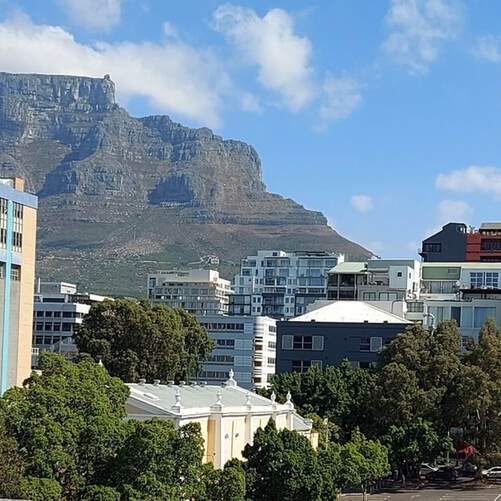
March 14 — Cape Town
Table Mountain, left, as seen from our balcony. This morning the mountain was shrouded in fog, and clouds, not a day to visit. Instead, we took a lazy walk around the V&A waterfront. Lots of music and activities entertained us for hours.
In North America, toilet paper is flying off the shelves as well as many food items as people are hoarding and panicking over the coronavirus. Worse, the first sign of a sniffle, they are at the hospital putting an enormous strain on the medical system. In South Africa, 20 cases have been reported and it’s life as usual. We wash our hands regularly, and avoid touching our face, not because we fear the virus, but because we fear a sneeze will keep you from boarding your flight. We passed a mangy group of young black men on our walk to the grocery store, all laying on the grass on the corner of the street. I bought a bag of apples and offer it to them on our return trip. They accepted so eagerly, and all stood to express their thanks “Thank you mama, thank you”. I realized how hungry they were. I have never gone hungry. It was heart breaking.
Table Mountain, left, as seen from our balcony. This morning the mountain was shrouded in fog, and clouds, not a day to visit. Instead, we took a lazy walk around the V&A waterfront. Lots of music and activities entertained us for hours.
In North America, toilet paper is flying off the shelves as well as many food items as people are hoarding and panicking over the coronavirus. Worse, the first sign of a sniffle, they are at the hospital putting an enormous strain on the medical system. In South Africa, 20 cases have been reported and it’s life as usual. We wash our hands regularly, and avoid touching our face, not because we fear the virus, but because we fear a sneeze will keep you from boarding your flight. We passed a mangy group of young black men on our walk to the grocery store, all laying on the grass on the corner of the street. I bought a bag of apples and offer it to them on our return trip. They accepted so eagerly, and all stood to express their thanks “Thank you mama, thank you”. I realized how hungry they were. I have never gone hungry. It was heart breaking.
|
March 15 — Activity in Cape Town
Abalone poachers were chased from Robben Island, 7 kilometres to the Cape Town coast where the poachers ran their zodiac up onto the reef. Police, coast guard, and poacher catchers (don’t know what government titles they have) chased them down on foot, arrested them and carted them away. The police struggled with the zodiac, but managed to get it off the beach and we're told it "will be crushed". Driving further along the Atlantic coast to Hout Bay, we watched locals charging tourists for taking pictures of a Cape Fur Seal, claiming it was their seal. On our return to our Cape Town apartment, our route took us directly through heavy smoke as we skirted the road with a wild grass fire. The smoke was thick. We held our breath, turned on our lights, and hustled through. When cars pulled over for the fire trucks, some drivers, “idiots” Con called them, took advantage and raced the trucks through the open lanes. |
March 16 — Fire Still Burns in Cape Town
We woke to clear skies, slight breezes, and what we thought would be a perfect day to visit Table Mountain. Driving the road to the gondola this morning, passing the area we drove by yesterday (to skirt the fire), we learned that fire fighters were still battling it. Sirens continue to race passed us. Yesterday, more than 200 fire fighters were fighting the fire. It's Cape Town’s most expensive neighbourhood with houses valued at more than US$10 million. Some people had to be evacuated yesterday, as the Table Mountain fire raged and jumped to Signal Hill thanks to the increasing wind speeds. Well into the night, we heard sirens as trucks passed our apartment. We are about a kilometre from the fire, but wind is blowing the smoke away from our place.
One Week Remains
With one week remaining for us in this extraordinary country, we have witnessed its beauty and colourful contrasts. Despite COVID-19 putting many international tourists sites on lock down. So far, in South Africa has not quarantined citizens and visitors. We are cautiously washing our hands, not touching things, keeping a reasonable distance from other people, and avoiding crowds. Each day we check the flights to see if they are still open for business.
South Africa Observations:
* A country of contrasts.
* Breathtakingly stunning mountains, unlike any we’ve seen, green rolling hills, plains, and deserts.
* Excellent roads, and gravel or beat-up potholed roads.
* Beautiful neighbourhoods, and under developed townships, and shantytown where houses are made of rotting wood with tin roofs and outhouses. Three times, we passed townships, where riots had just ended, burned rubbish was smouldering on the road and shoulder, and had to drive over broken glass holding our breath that it wouldn’t pop or puncture our tires. In two locations, riot police were parked at an intersection, one was a SWAT van.
* Unemployment runs about 30 percent with another 10 percent falling off the grid. Fifty percent of those numbers are youth. Closures and slow downs in manufacturing, utilities, and industry has made a huge contribution to these numbers.
* Lots of people destitute, especially in Cape Town where migrants have fled for a better life. Maybe it has been good for some, but others are starving. In every city and town, self-appointed attendants wave you to an available spot for the equivalent of 50 cents Canadian. Yesterday, a skinny man walked into a busy intersection stopping traffic with his hand out to stop cars and then tried to usher us across for a coin. We smiled, shook our head and waited for the light.
* Service in restaurants and hotels is excellent, and gas station attendants are like nowhere else. One guy pumps, another washes your windows for the equivalent of 50 cents Canadian. Once, four guys washed our entire car, with soap and buckets of water, shammy it dry in minutes for a double tip. One young man spotted our leaking tire and plugged it on the spot using a repair kit, all for less than the equivalent of $5 Canadian.
* Electric load shedding is an on-going issue in South Africa. Just outside Cape Town especially, power is shut down for hours at a time because there isn’t enough capacity for the country.
* Birds are many and colourful, and some of Earth’s most cherished, wildest, and largest animals reside here.
We woke to clear skies, slight breezes, and what we thought would be a perfect day to visit Table Mountain. Driving the road to the gondola this morning, passing the area we drove by yesterday (to skirt the fire), we learned that fire fighters were still battling it. Sirens continue to race passed us. Yesterday, more than 200 fire fighters were fighting the fire. It's Cape Town’s most expensive neighbourhood with houses valued at more than US$10 million. Some people had to be evacuated yesterday, as the Table Mountain fire raged and jumped to Signal Hill thanks to the increasing wind speeds. Well into the night, we heard sirens as trucks passed our apartment. We are about a kilometre from the fire, but wind is blowing the smoke away from our place.
One Week Remains
With one week remaining for us in this extraordinary country, we have witnessed its beauty and colourful contrasts. Despite COVID-19 putting many international tourists sites on lock down. So far, in South Africa has not quarantined citizens and visitors. We are cautiously washing our hands, not touching things, keeping a reasonable distance from other people, and avoiding crowds. Each day we check the flights to see if they are still open for business.
South Africa Observations:
* A country of contrasts.
* Breathtakingly stunning mountains, unlike any we’ve seen, green rolling hills, plains, and deserts.
* Excellent roads, and gravel or beat-up potholed roads.
* Beautiful neighbourhoods, and under developed townships, and shantytown where houses are made of rotting wood with tin roofs and outhouses. Three times, we passed townships, where riots had just ended, burned rubbish was smouldering on the road and shoulder, and had to drive over broken glass holding our breath that it wouldn’t pop or puncture our tires. In two locations, riot police were parked at an intersection, one was a SWAT van.
* Unemployment runs about 30 percent with another 10 percent falling off the grid. Fifty percent of those numbers are youth. Closures and slow downs in manufacturing, utilities, and industry has made a huge contribution to these numbers.
* Lots of people destitute, especially in Cape Town where migrants have fled for a better life. Maybe it has been good for some, but others are starving. In every city and town, self-appointed attendants wave you to an available spot for the equivalent of 50 cents Canadian. Yesterday, a skinny man walked into a busy intersection stopping traffic with his hand out to stop cars and then tried to usher us across for a coin. We smiled, shook our head and waited for the light.
* Service in restaurants and hotels is excellent, and gas station attendants are like nowhere else. One guy pumps, another washes your windows for the equivalent of 50 cents Canadian. Once, four guys washed our entire car, with soap and buckets of water, shammy it dry in minutes for a double tip. One young man spotted our leaking tire and plugged it on the spot using a repair kit, all for less than the equivalent of $5 Canadian.
* Electric load shedding is an on-going issue in South Africa. Just outside Cape Town especially, power is shut down for hours at a time because there isn’t enough capacity for the country.
* Birds are many and colourful, and some of Earth’s most cherished, wildest, and largest animals reside here.
March 17 — At the waterfront, the Cape Fur Seals dominate the inner harbour. They are only found in Cape Town and Hout Bay (very near to Cape Town). They lay on their backs tucking their heads backwards underwater and fan with their fins above water.
As everything seems to be moving toward lockdown here, we walked to Qatar Airlines to investigate an earlier departure back to Portugal. The soonest we could leave was Friday (3 days earlier) which we accepted. We will forfeit our separately purchased flight to Johannesburg, to fly from Cape Town via Johannesburg, Doha, London, to Lisbon.
Below: Since Table Mountain is closed, we drove to the top of neighbouring Signal Hill for a spectacular 360 degree view of Cape Town. On the way up, we could see how the fire a few days ago cleaned up the brush, and burned a few cars and houses. Fire fighters are still on standby in the event the smouldering re-ignites. Tourists sites are now closing everywhere.
As everything seems to be moving toward lockdown here, we walked to Qatar Airlines to investigate an earlier departure back to Portugal. The soonest we could leave was Friday (3 days earlier) which we accepted. We will forfeit our separately purchased flight to Johannesburg, to fly from Cape Town via Johannesburg, Doha, London, to Lisbon.
Below: Since Table Mountain is closed, we drove to the top of neighbouring Signal Hill for a spectacular 360 degree view of Cape Town. On the way up, we could see how the fire a few days ago cleaned up the brush, and burned a few cars and houses. Fire fighters are still on standby in the event the smouldering re-ignites. Tourists sites are now closing everywhere.
|
March 18 — COVID Virus is Becoming World-Wide
Unlike places in Europe where people are not allowed outside their homes unless going to the pharmacy or grocery store, we can still walk about or sight see by car. All tourist sites, large public gatherings, churches, libraries, museums, and some restaurants are closed here in Cape Town, but there are still delightful things to do and not create complications that could spread germs. Slowing down we are enjoying our apartment with a first-class view of Table Mountain from our balcony. After our lazy morning, we sterilized ourselves and set out on foot to the nearby Company Park and Botanical Garden, a 3.2 hectare free park in the heart of Cape Town. It dates back to 1652 when Dutch settlers had started a garden to replenish their sea-going vessels with vegetables when they’d stop in Cape Town either coming or going from China, India, and Indonesia. This gum tree, pictured, has experienced much of Cape Town’s history, standing proud in the middle of the garden. Below, Cetshwayo kaMpande, the king of the Zulu. And Table Mountain, from The Company Park. |
March 19 -- Almost everything is now shut down in Cape Town. We walked to the Cape Town Castle, a simple structure that once guarded Cape Town first for the Dutch, and then for the Brits. The Zulu King, came from the tribe of the greatest warriors. In 1879, the king led the Anglo-Zulu War to victory against the British. He was eventually defeated and exiled to the castle prison.
Below: Nommoä Goringhaiqua, leader of the 1659 Khoi-Dutch War (imprisoned at the castle)
King Langalinalele of the Amattlubi was imprisoned for treason in 1874 (pictured in military uniform)
King Sekhukhune of the BaPedi, a fearless leader captured in 1879 and imprisoned.
Below: Nommoä Goringhaiqua, leader of the 1659 Khoi-Dutch War (imprisoned at the castle)
King Langalinalele of the Amattlubi was imprisoned for treason in 1874 (pictured in military uniform)
King Sekhukhune of the BaPedi, a fearless leader captured in 1879 and imprisoned.
March 20 — Third Attempt to Return to Portugal
Our previous two scheduled flights have now been cancelled. So far, we will leave on Thursday afternoon from Cape Town on South African Airlines, changing to Qatar Airways in Johannesburg, flying to Doha, then to London, changing to British Airways and arriving in Lisbon 26 hours later. We'll overnight in Lisbon and carry on to Lagos by train on Sunday and then we'll self isolate. At this point, Portugal is in lockdown so we are unsure if trains are running, or if car rentals are an option. We worked with our Portuguese lawyer yesterday obtaining certified legal documents declaring us “nearly” Portuguese Residents, to ease us through the border with Canadian passports. Flying to Canada would leave us without a house to self isolate, since our two properties are rented and we are NOT allowed (government rules) to bunk in with our families. Con is looking for a small apartment in Cape Town in the event we get stuck here.
Our previous two scheduled flights have now been cancelled. So far, we will leave on Thursday afternoon from Cape Town on South African Airlines, changing to Qatar Airways in Johannesburg, flying to Doha, then to London, changing to British Airways and arriving in Lisbon 26 hours later. We'll overnight in Lisbon and carry on to Lagos by train on Sunday and then we'll self isolate. At this point, Portugal is in lockdown so we are unsure if trains are running, or if car rentals are an option. We worked with our Portuguese lawyer yesterday obtaining certified legal documents declaring us “nearly” Portuguese Residents, to ease us through the border with Canadian passports. Flying to Canada would leave us without a house to self isolate, since our two properties are rented and we are NOT allowed (government rules) to bunk in with our families. Con is looking for a small apartment in Cape Town in the event we get stuck here.
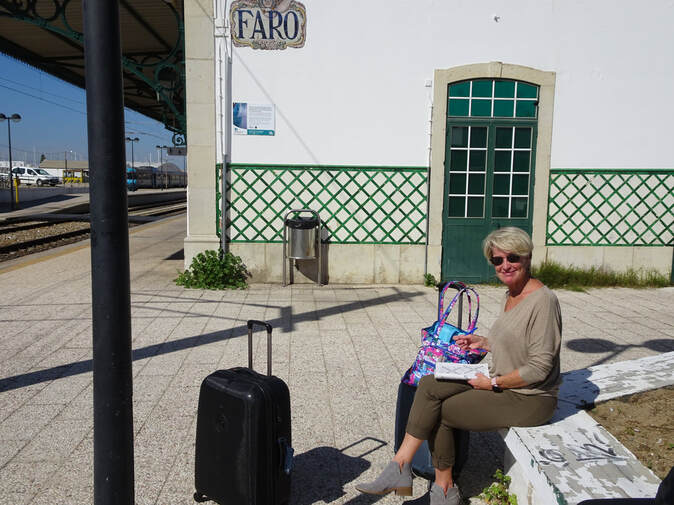
March 23 -- Back Aboard on Day 2 in Self Isolation
We wish you all health and hope we can crush this virus. It's an unprecedented time in our history. Con and I completed our marathon return to Big Sky having been in transit for 37 hours to get to our Lisbon hotel. Our last trek yesterday involved two trains adding another 4 hours. The last stop though is conveniently right in front of the marina. We were two of less than 8 or 10 people on the trains. We were lucky for many things: British Airways was still flying into Portugal; the subway was still operating (gates were wide open, no staff, no tickets required); and the trains still operating. We stepped off, wheeled through the once buzzing marina to a completely empty quay, no restaurants open, no music playing, no happy chatter and laughter. Someone biked passed us completely covered mouth and gloved hands. No eye contact. No hello. Another man walked passed, turning his head away. Again, no hello. Still masked, we opened the boat, turned on the fridge and walked to the Lidl. Few people were shopping. A guard at the door counted the numbers of people in and out. Tape was placed on the floor to keep separation from the cashier. We reached over to make payment and collect our food. Shelves are well stocked.
A few days ago in Cape Town:
The COVID-19 virus crisis was changing globally as fast as you could blink. Word was that Portugal would be closing their borders. We walked to Qatar Airways to attempt an earlier return. They were extraordinary in their professionalism. It took two attempts to get to Portugal, since the first changed flight cancelled the leg from Doha to Lisbon. They managed to get us from Doha to London and onto British Airways to Lisbon. We weren't at all confident that we'd make it out of Cape Town and began looking for apartment rentals. However, we got on our first flight, to Johannesburg which almost became our last. Officials took one look at our Canadian passports and our destination Lisbon, and stated: “No. Residents only.” Anticipating trouble, we had contacted our Portuguese lawyer the day before and they quickly provided us with documentation stating that our residency was pending with the purchase of our house. Con pulled out the lawyers papers and they disappeared with them and our passports. We waited. Waited. Waited. Nearly everyone had boarded and finally someone rushed to us telling us to follow them. A form was handed to us to fill out and sign. We did. Neither of us know what we signed. Qatar staff then scurried us aboard and the doors closed. With a late arrival in Doha, we rushed through security and to our next plane, to London. From there, we walked to the British Airways flight and landed in Lisbon with no issues.
The next morning in our Lisbon hotel, we read in The Portuguese news that there is strict enforcement of the isolation rules and without compliance it can be up to one year in jail (in Portugal). It says, “...anyone returning from abroad including foreign residents will be stopped, questioned, told of the isolation, names taken, and follow up done...”
This is what happened: Stepping up to the Immigration booth, the officer looked at our Canadian passports and asked, Where are you going?”
This is the moment we dreaded wondering if we’d be turned away. Con responded, “To our boat in Lagos.” He stamped our passports and there was no talk about self isolating. We arrived to near echoes in the Lisbon airport. Our suitcase didn't make it. A person took our missing suitcase details and by the time we walked to the exit doors, no one else was in the airport except two officials who called to us abruptly, "Separation!" Looking down, we saw lines taped to the floor every two meters. We complied. Once out, I whispered to Con, "Do you think they know we've been sleeping together?" Outside the airport, Con called to one of the two police officers, "Is the subway running?" He nodded. We crossed the outside tarmac and entered an empty subway. The gates were wide open. No ticket required. Two others waited for the subway. Wearing our masks, we stepped out into the Oriente neighbourhood (where we'd take the trains to Lagos in the morning). Con walked toward an officer (just about the only other people walking about) and called, "Is the mall opened."
"No."
We were after internet.
We walked through the doors of the Tryp Hotel, checked in to learn that when we check out, they were locking up the hotel. Nobody was on the streets, few cars or trucks. Lisbon was a ghost town.
Not one person stopped us other than in Johannesburg. No one told us to self isolate (which we are doing minus the trip to the Lidl for supplies). No one took our details. Nobody checked our health, temperature (unlike a month ago when we arrived in Johannesburg and had three separate temperature checks). Not a single person asked us anything related to us potentially having the virus or being in touch with someone who has. As far as we know we are uncontaminated and healthy.
During our journey, we witnesses some tense people. One wore a head to toe hazmat suit, half or more wore masks and gloves, and all attempting to keep separation from each other. If we got too close to some people, they wouldn’t hesitate to demand (in panicked voices) to “Give space!”
Well, this ends our awesome month in South Africa. It was a place we'd thought about going to and we're glad we did.
We wish you all health and hope we can crush this virus. It's an unprecedented time in our history. Con and I completed our marathon return to Big Sky having been in transit for 37 hours to get to our Lisbon hotel. Our last trek yesterday involved two trains adding another 4 hours. The last stop though is conveniently right in front of the marina. We were two of less than 8 or 10 people on the trains. We were lucky for many things: British Airways was still flying into Portugal; the subway was still operating (gates were wide open, no staff, no tickets required); and the trains still operating. We stepped off, wheeled through the once buzzing marina to a completely empty quay, no restaurants open, no music playing, no happy chatter and laughter. Someone biked passed us completely covered mouth and gloved hands. No eye contact. No hello. Another man walked passed, turning his head away. Again, no hello. Still masked, we opened the boat, turned on the fridge and walked to the Lidl. Few people were shopping. A guard at the door counted the numbers of people in and out. Tape was placed on the floor to keep separation from the cashier. We reached over to make payment and collect our food. Shelves are well stocked.
A few days ago in Cape Town:
The COVID-19 virus crisis was changing globally as fast as you could blink. Word was that Portugal would be closing their borders. We walked to Qatar Airways to attempt an earlier return. They were extraordinary in their professionalism. It took two attempts to get to Portugal, since the first changed flight cancelled the leg from Doha to Lisbon. They managed to get us from Doha to London and onto British Airways to Lisbon. We weren't at all confident that we'd make it out of Cape Town and began looking for apartment rentals. However, we got on our first flight, to Johannesburg which almost became our last. Officials took one look at our Canadian passports and our destination Lisbon, and stated: “No. Residents only.” Anticipating trouble, we had contacted our Portuguese lawyer the day before and they quickly provided us with documentation stating that our residency was pending with the purchase of our house. Con pulled out the lawyers papers and they disappeared with them and our passports. We waited. Waited. Waited. Nearly everyone had boarded and finally someone rushed to us telling us to follow them. A form was handed to us to fill out and sign. We did. Neither of us know what we signed. Qatar staff then scurried us aboard and the doors closed. With a late arrival in Doha, we rushed through security and to our next plane, to London. From there, we walked to the British Airways flight and landed in Lisbon with no issues.
The next morning in our Lisbon hotel, we read in The Portuguese news that there is strict enforcement of the isolation rules and without compliance it can be up to one year in jail (in Portugal). It says, “...anyone returning from abroad including foreign residents will be stopped, questioned, told of the isolation, names taken, and follow up done...”
This is what happened: Stepping up to the Immigration booth, the officer looked at our Canadian passports and asked, Where are you going?”
This is the moment we dreaded wondering if we’d be turned away. Con responded, “To our boat in Lagos.” He stamped our passports and there was no talk about self isolating. We arrived to near echoes in the Lisbon airport. Our suitcase didn't make it. A person took our missing suitcase details and by the time we walked to the exit doors, no one else was in the airport except two officials who called to us abruptly, "Separation!" Looking down, we saw lines taped to the floor every two meters. We complied. Once out, I whispered to Con, "Do you think they know we've been sleeping together?" Outside the airport, Con called to one of the two police officers, "Is the subway running?" He nodded. We crossed the outside tarmac and entered an empty subway. The gates were wide open. No ticket required. Two others waited for the subway. Wearing our masks, we stepped out into the Oriente neighbourhood (where we'd take the trains to Lagos in the morning). Con walked toward an officer (just about the only other people walking about) and called, "Is the mall opened."
"No."
We were after internet.
We walked through the doors of the Tryp Hotel, checked in to learn that when we check out, they were locking up the hotel. Nobody was on the streets, few cars or trucks. Lisbon was a ghost town.
Not one person stopped us other than in Johannesburg. No one told us to self isolate (which we are doing minus the trip to the Lidl for supplies). No one took our details. Nobody checked our health, temperature (unlike a month ago when we arrived in Johannesburg and had three separate temperature checks). Not a single person asked us anything related to us potentially having the virus or being in touch with someone who has. As far as we know we are uncontaminated and healthy.
During our journey, we witnesses some tense people. One wore a head to toe hazmat suit, half or more wore masks and gloves, and all attempting to keep separation from each other. If we got too close to some people, they wouldn’t hesitate to demand (in panicked voices) to “Give space!”
Well, this ends our awesome month in South Africa. It was a place we'd thought about going to and we're glad we did.
